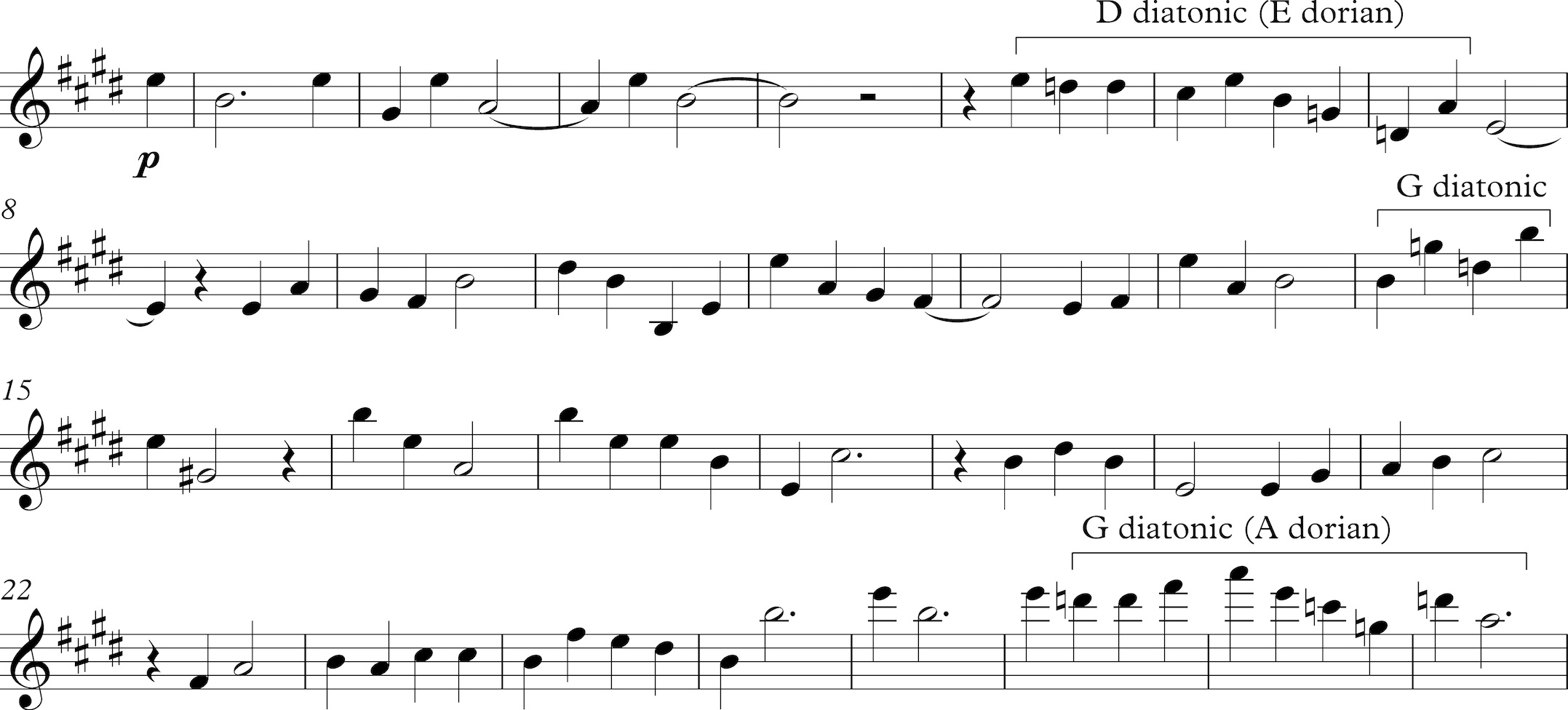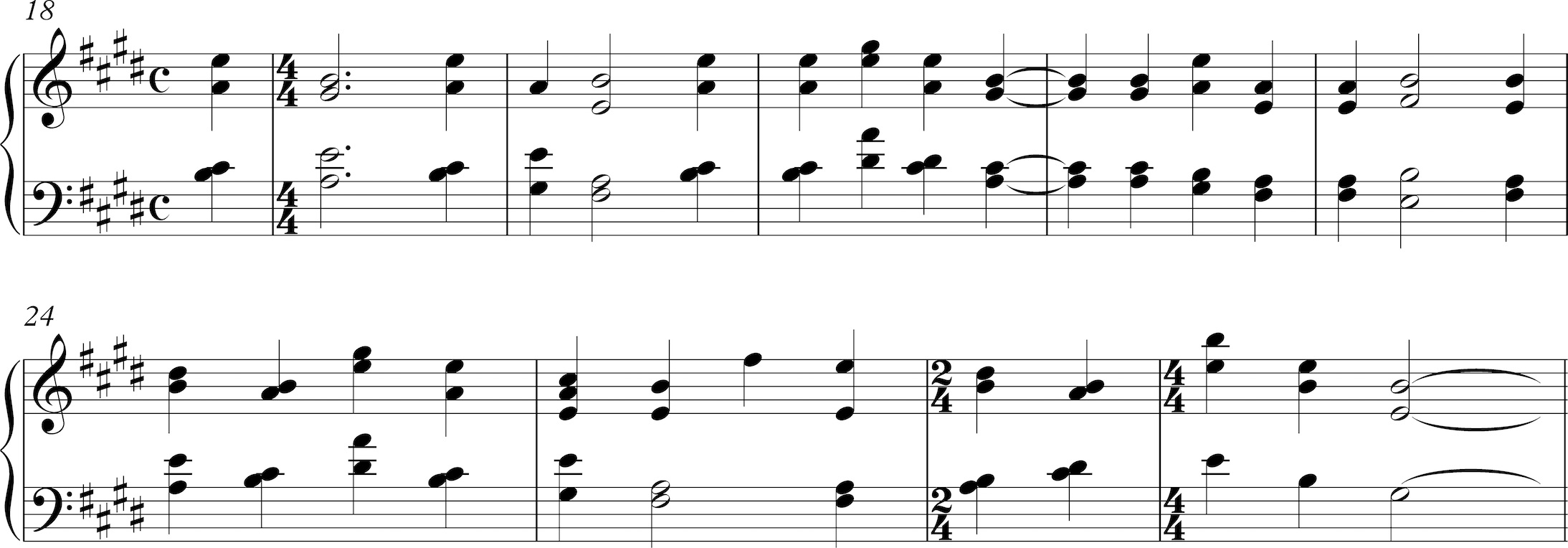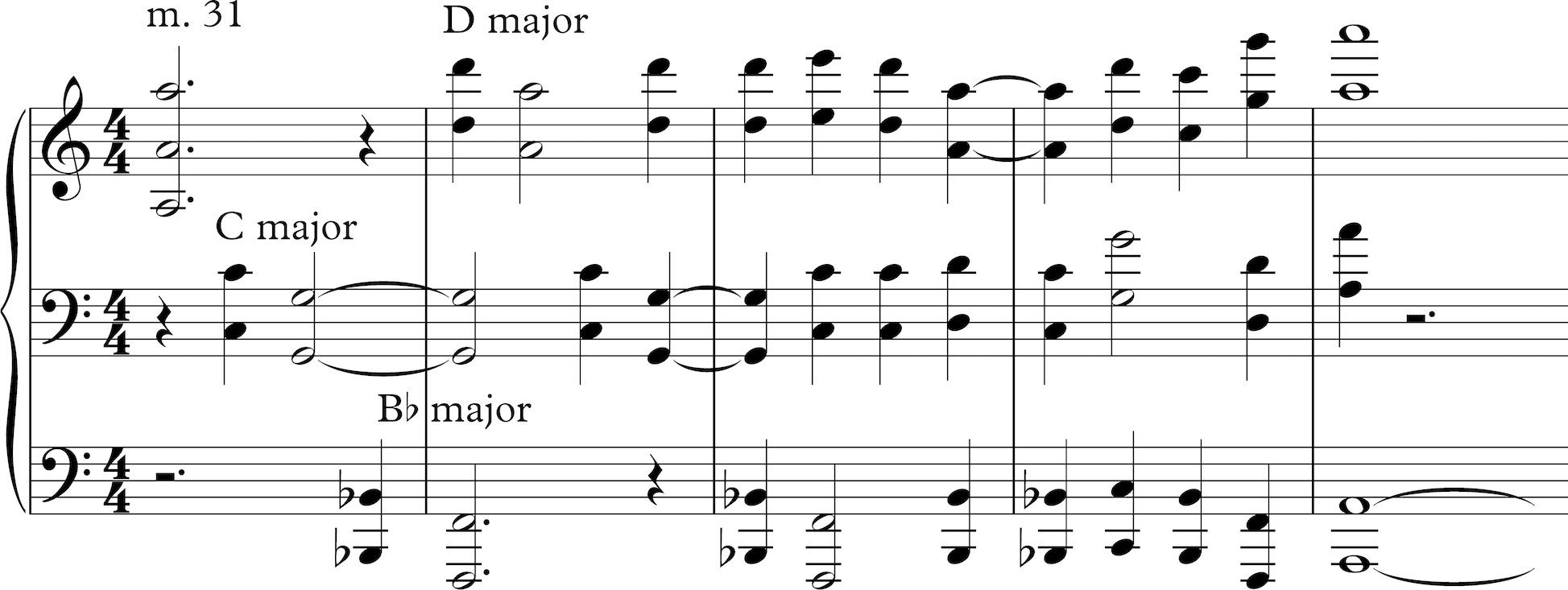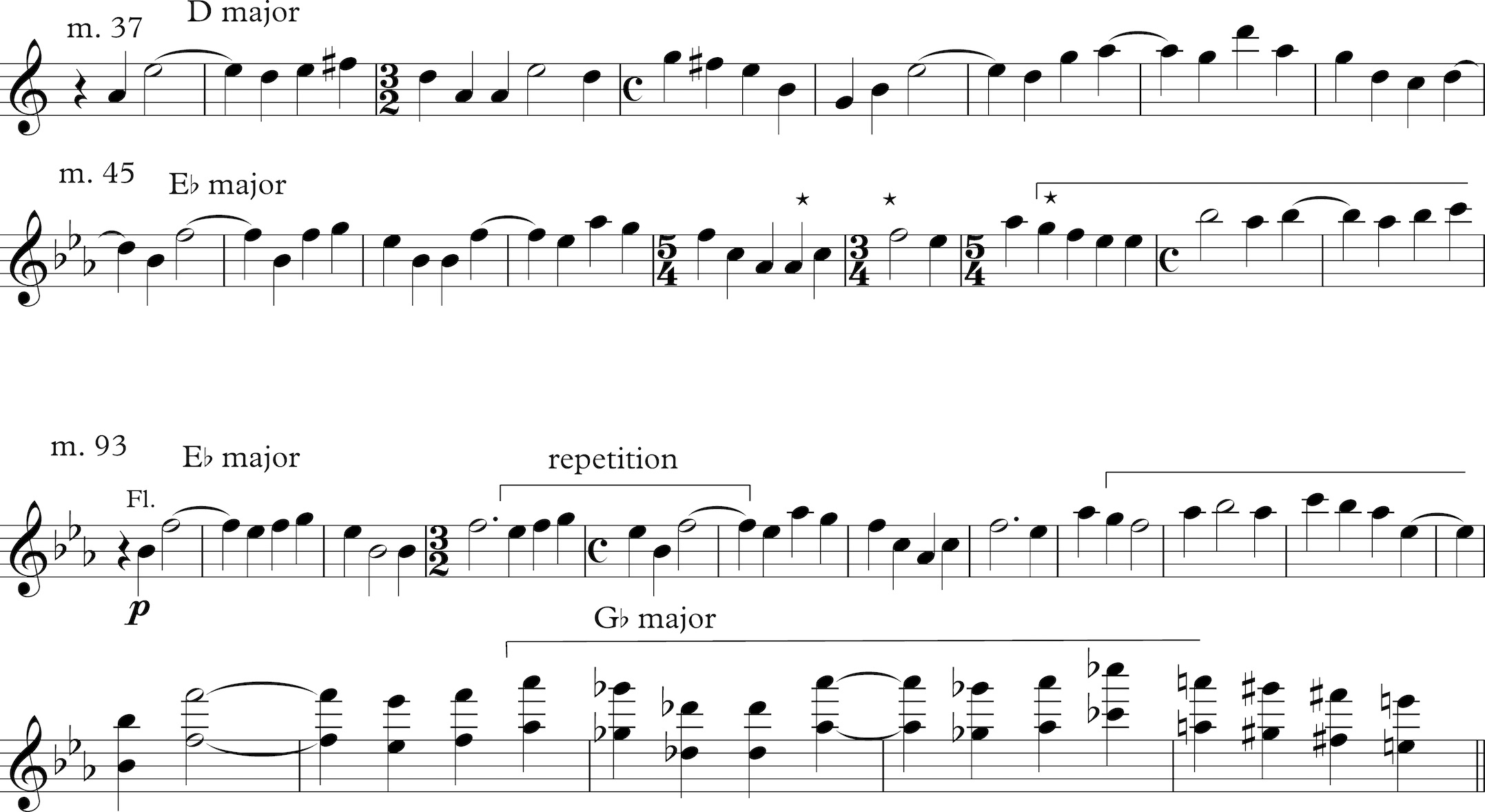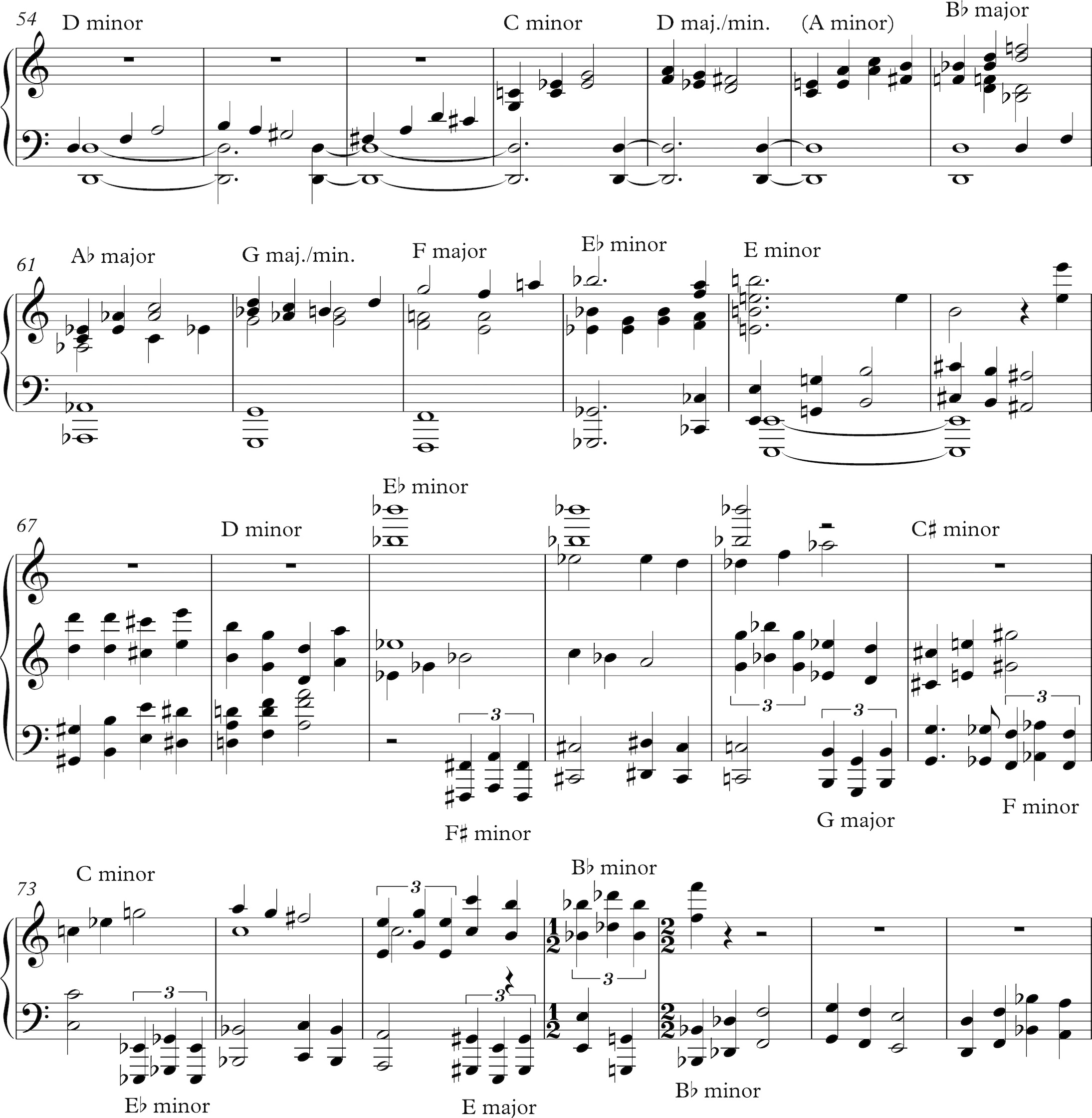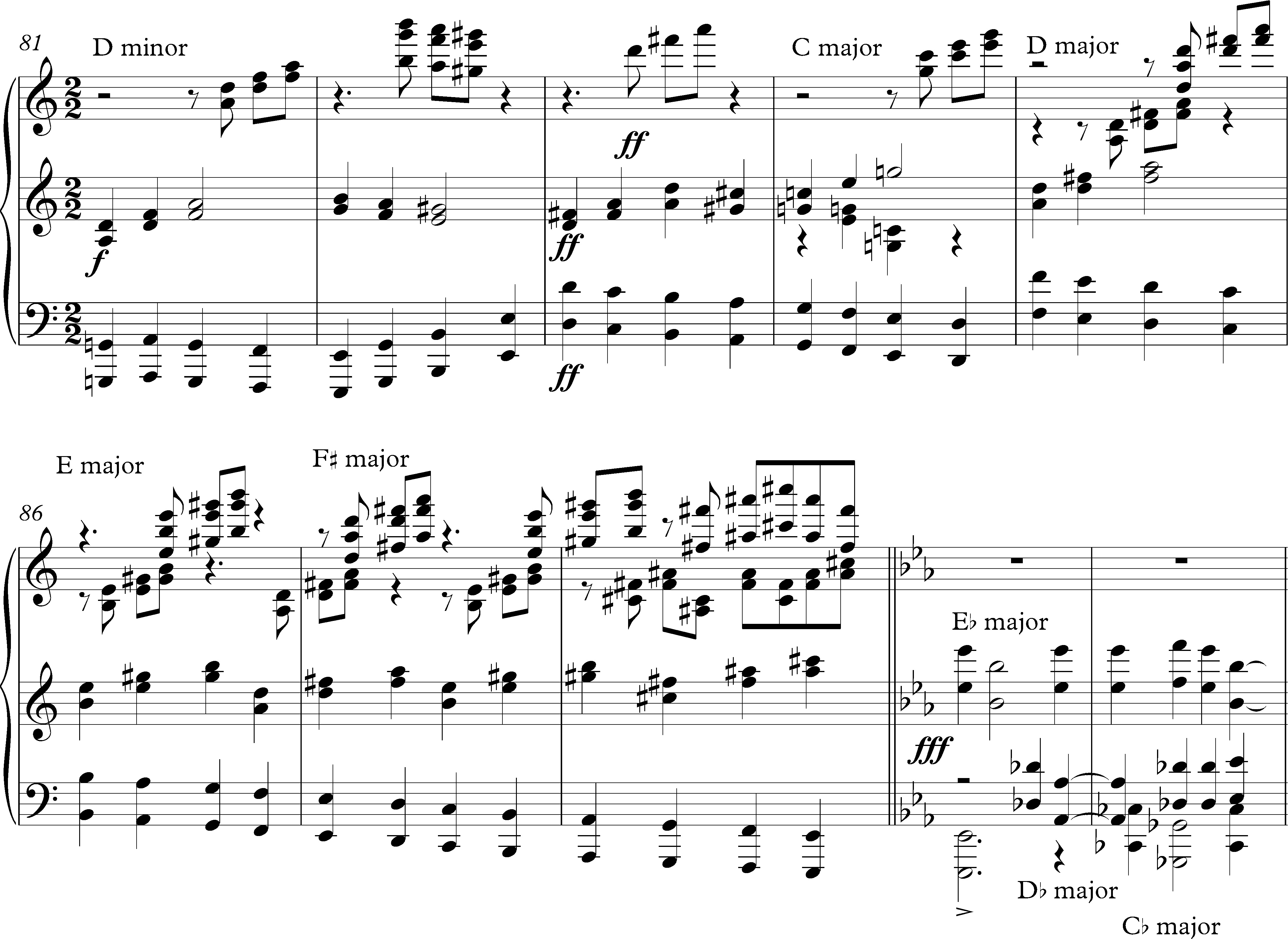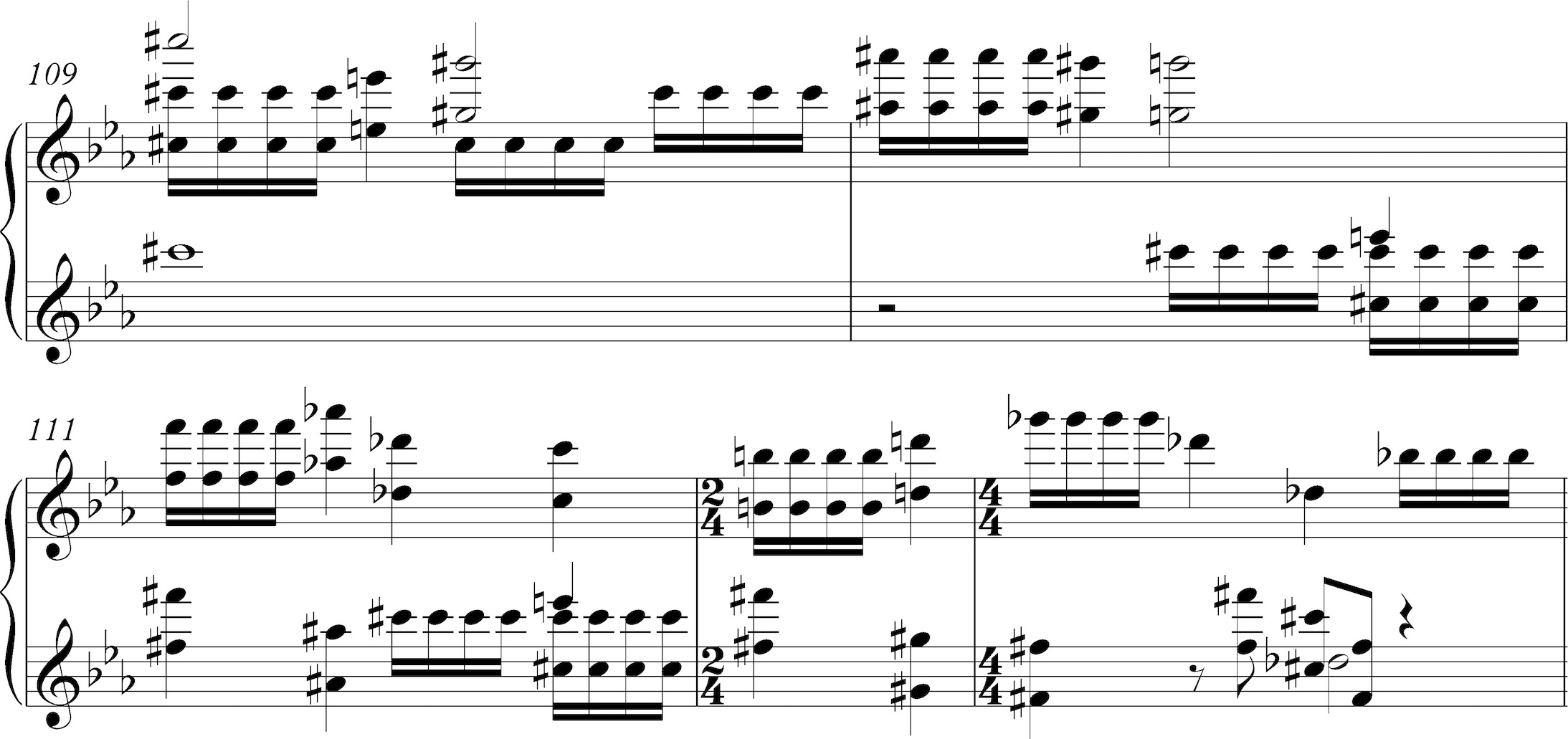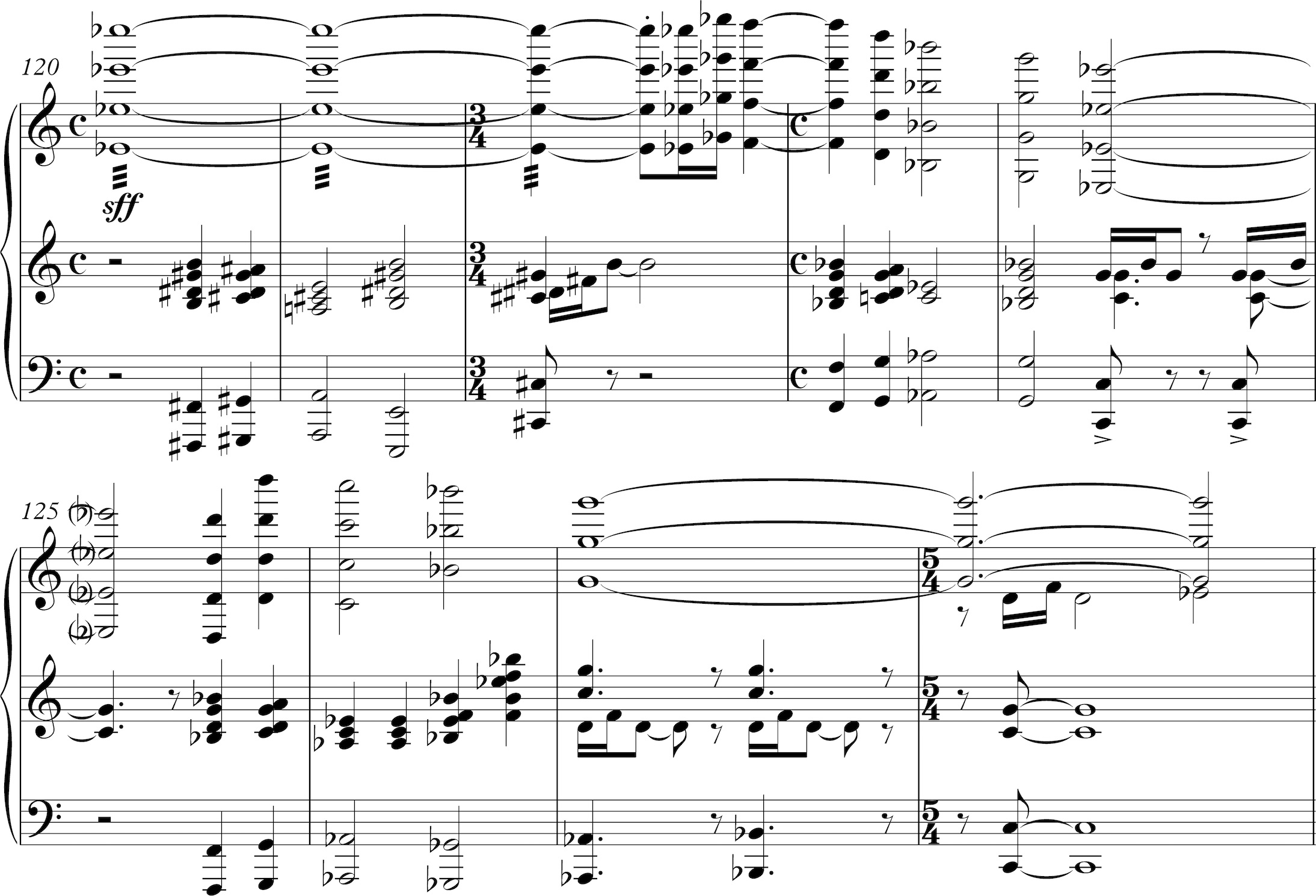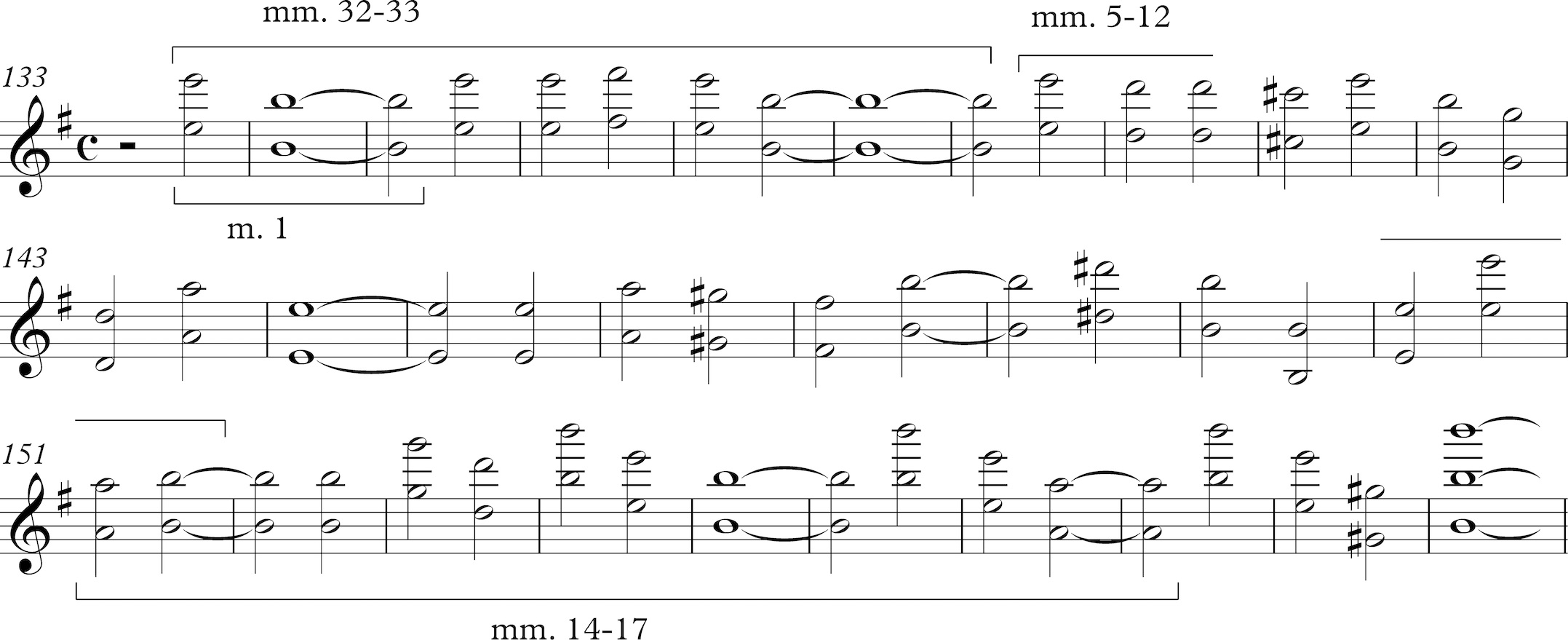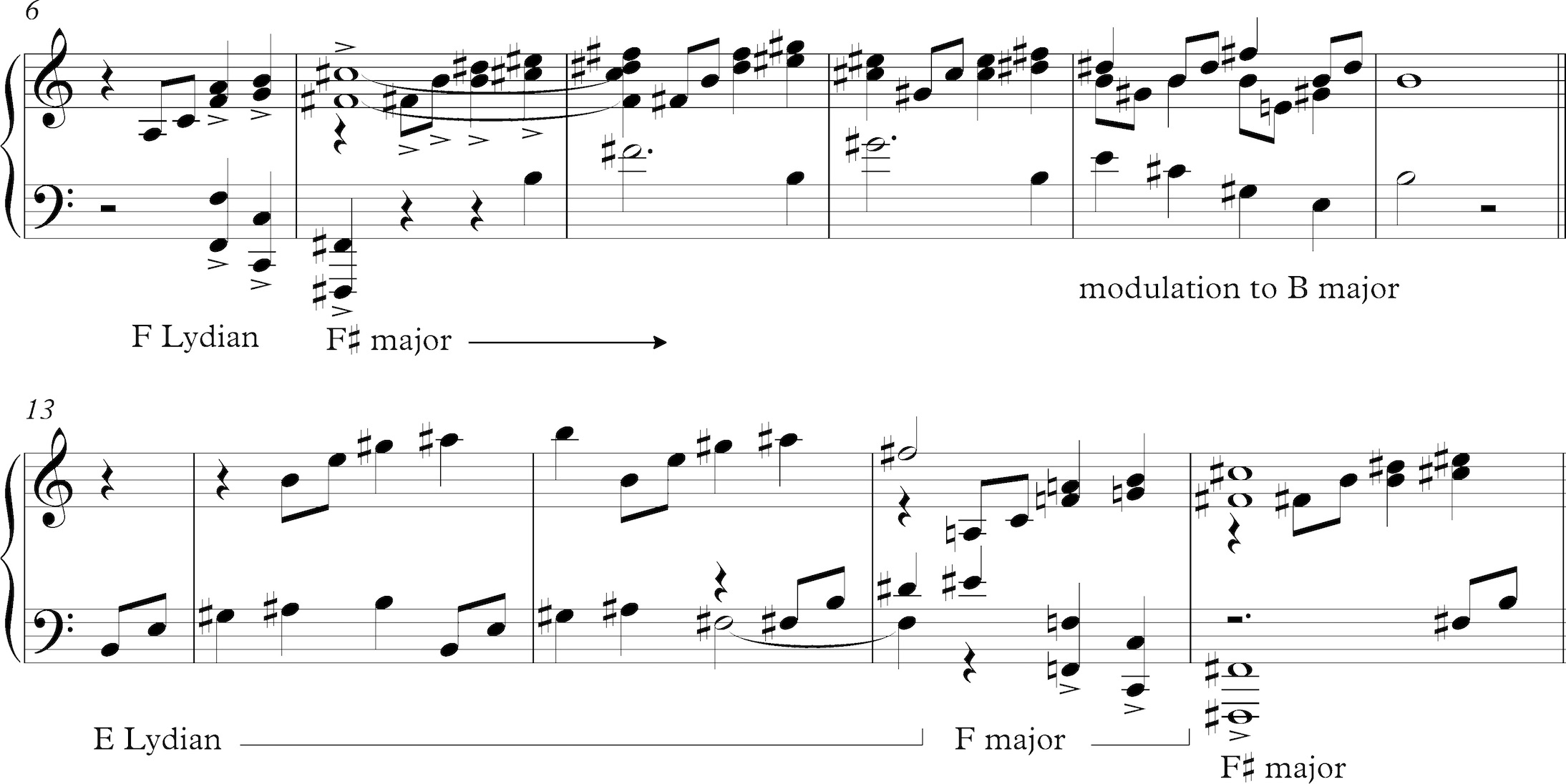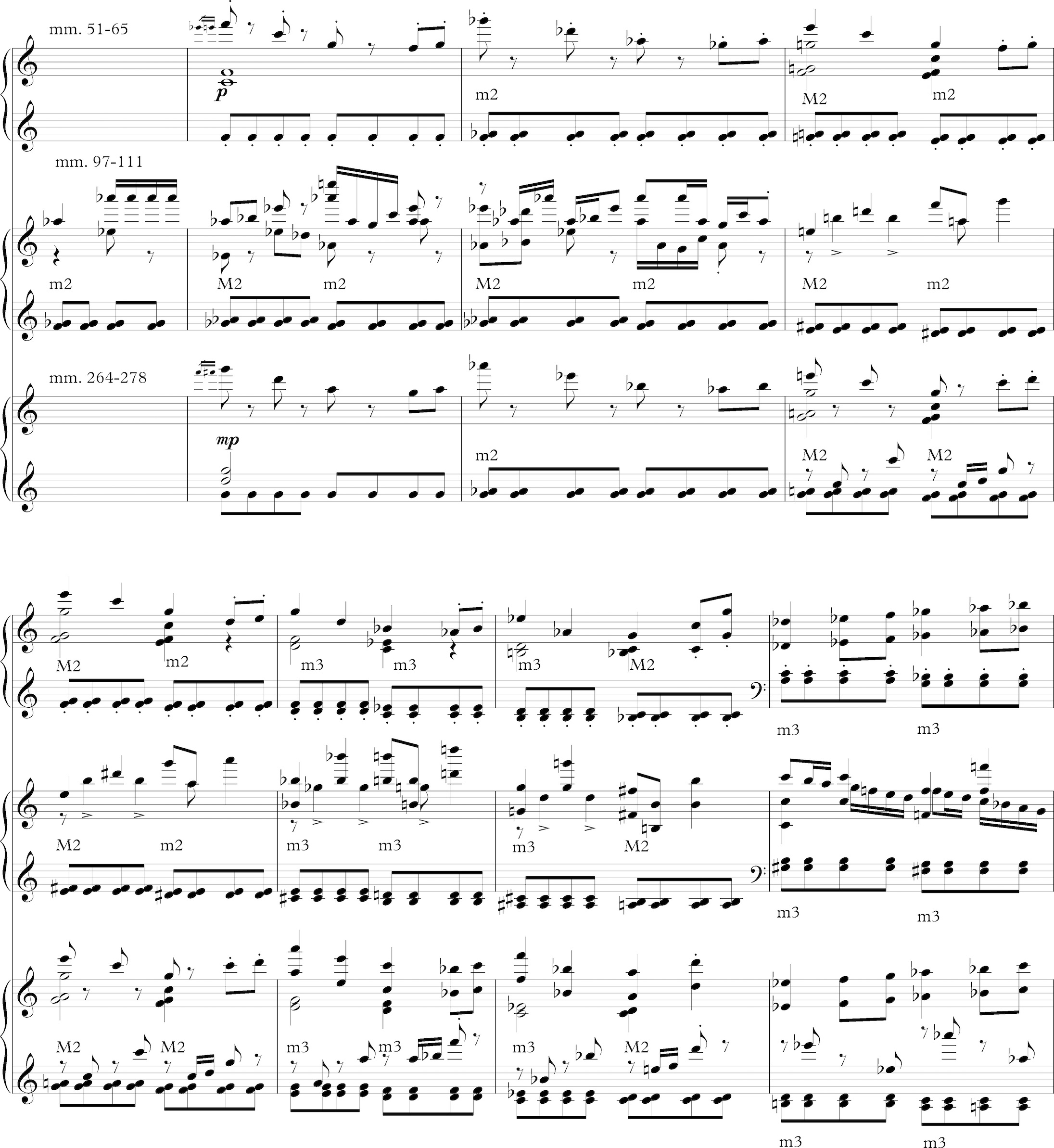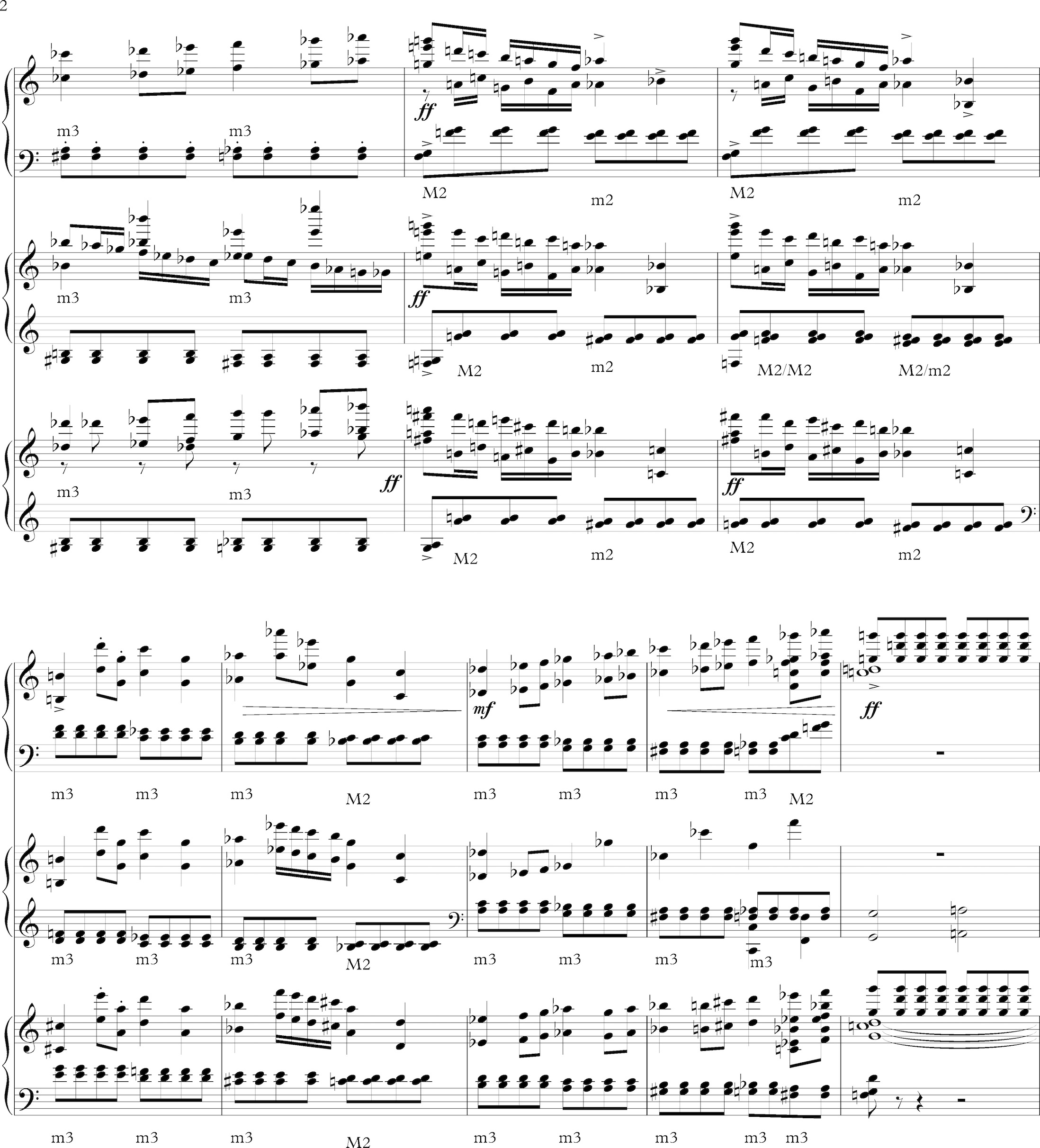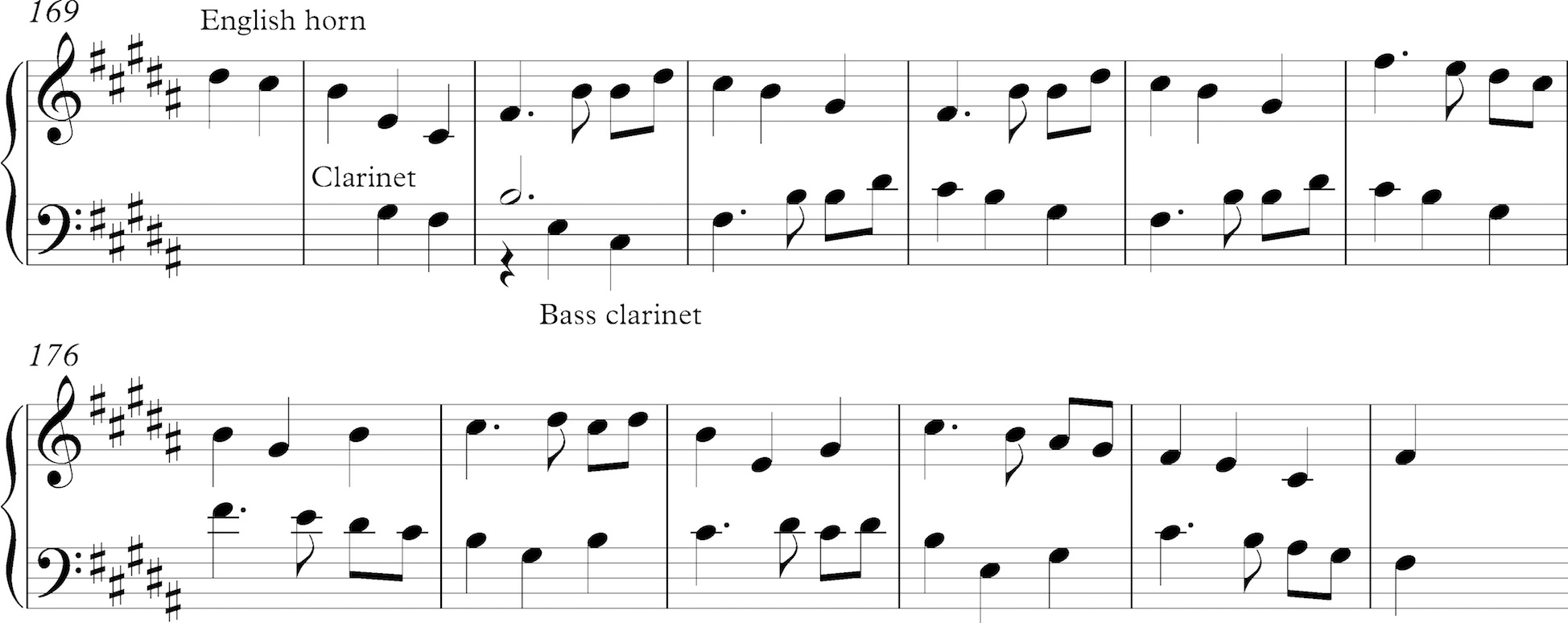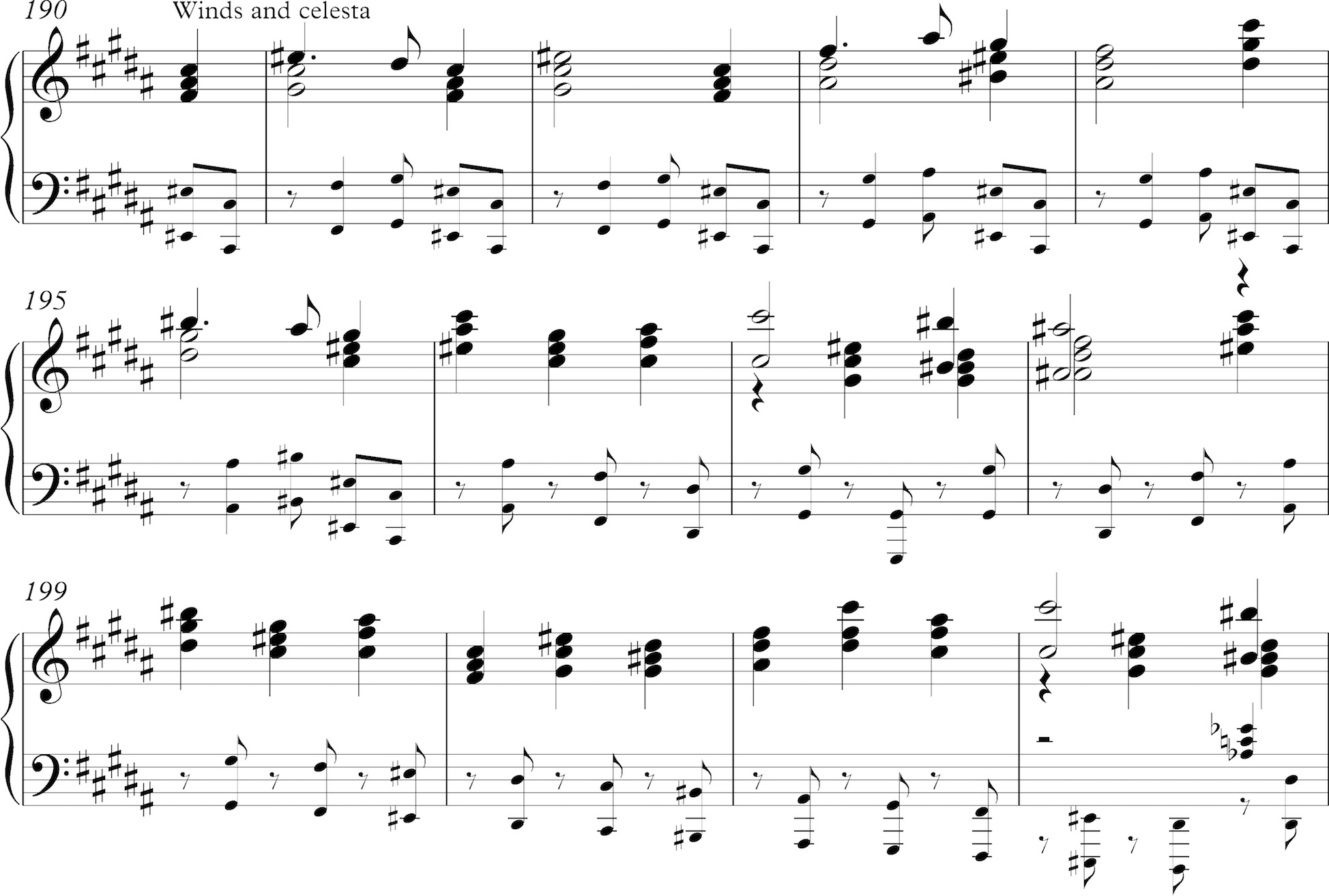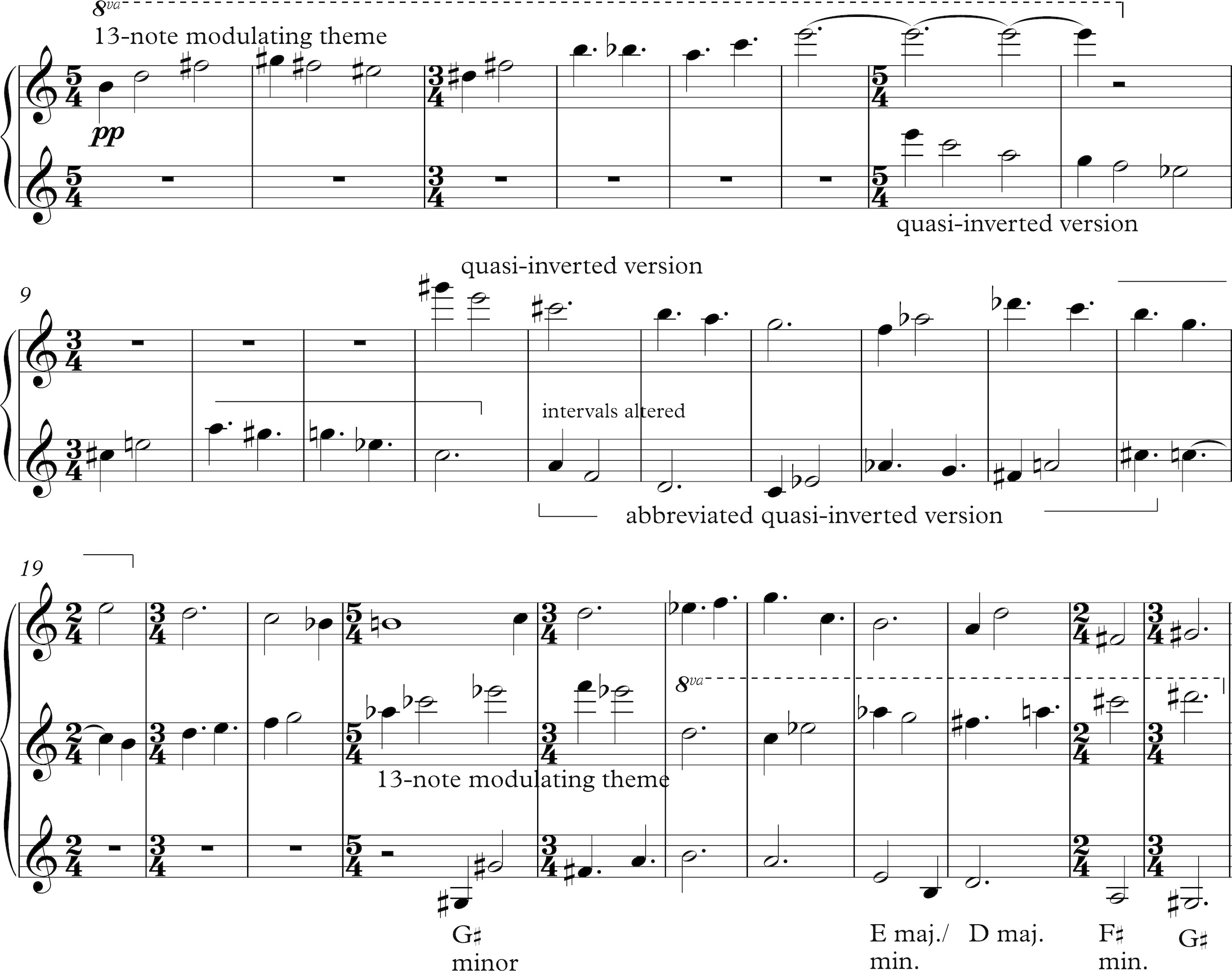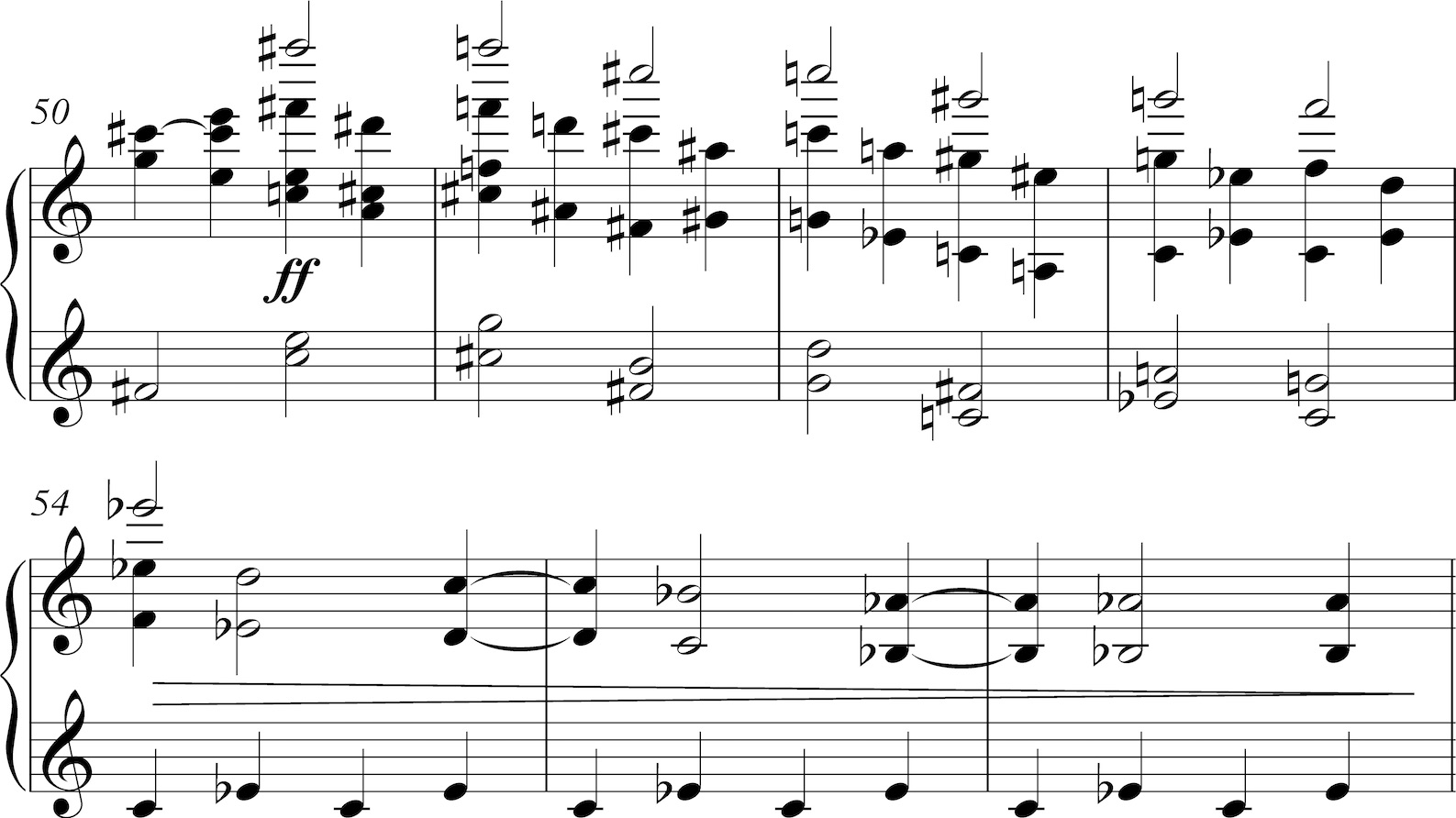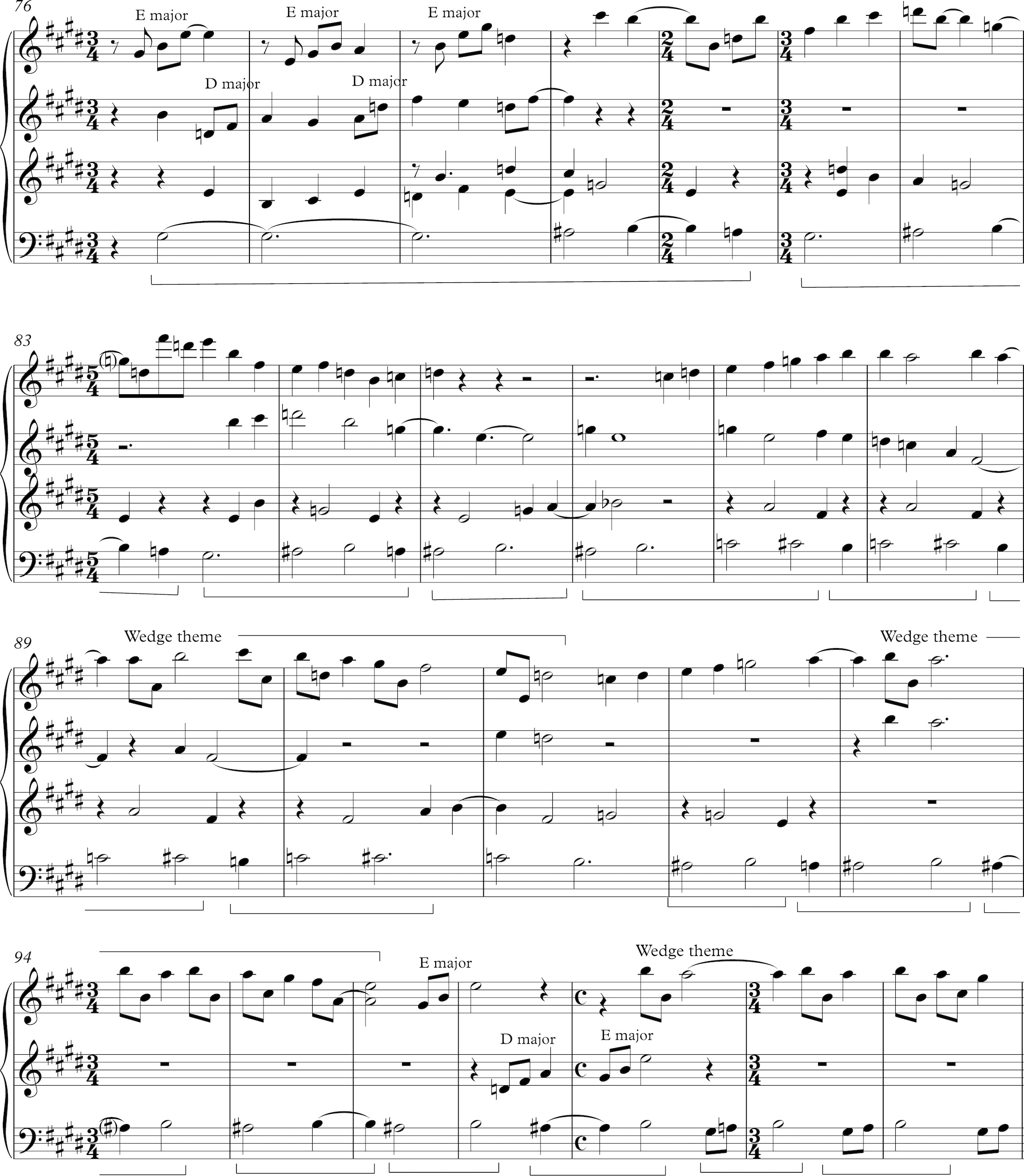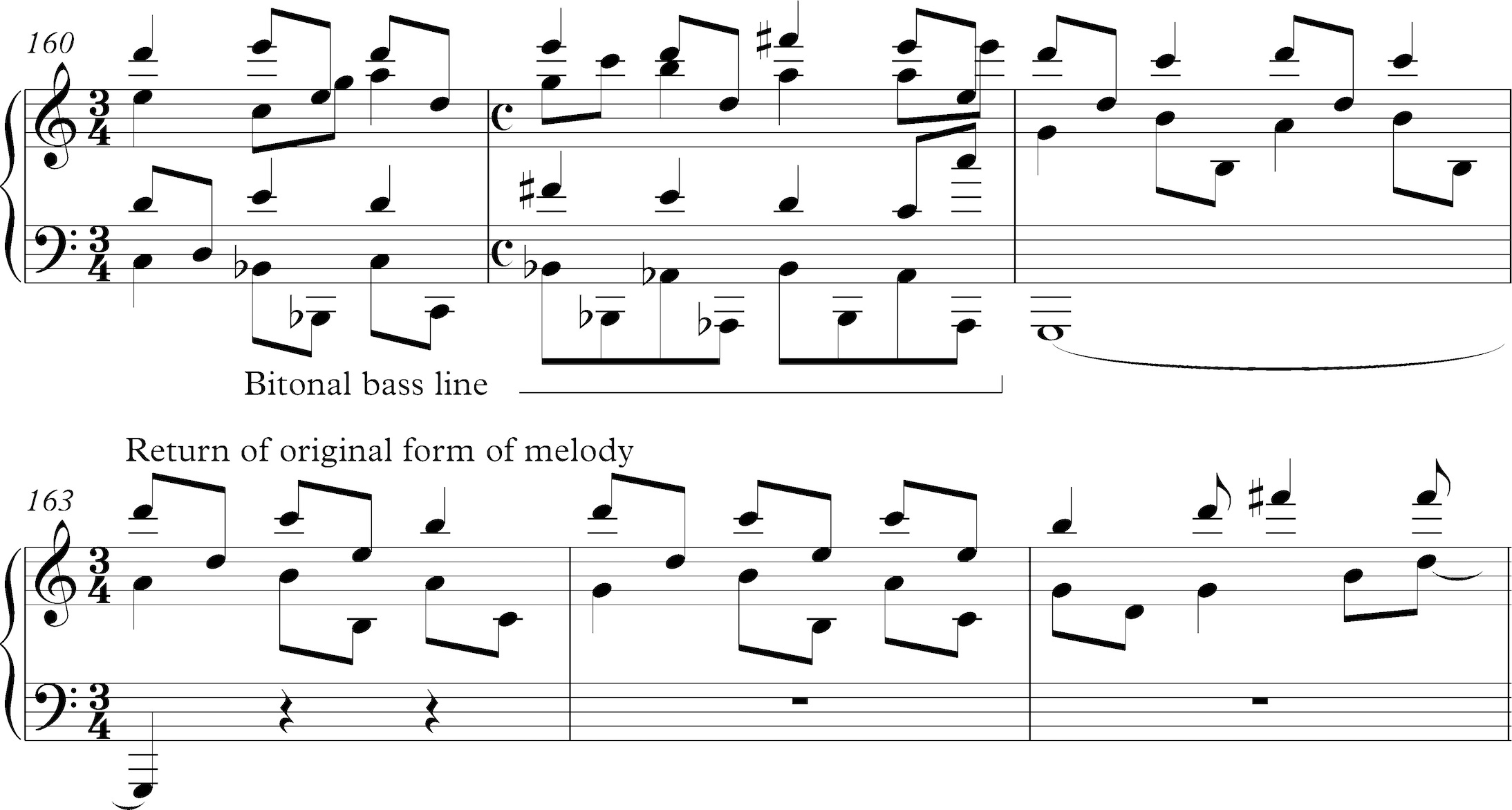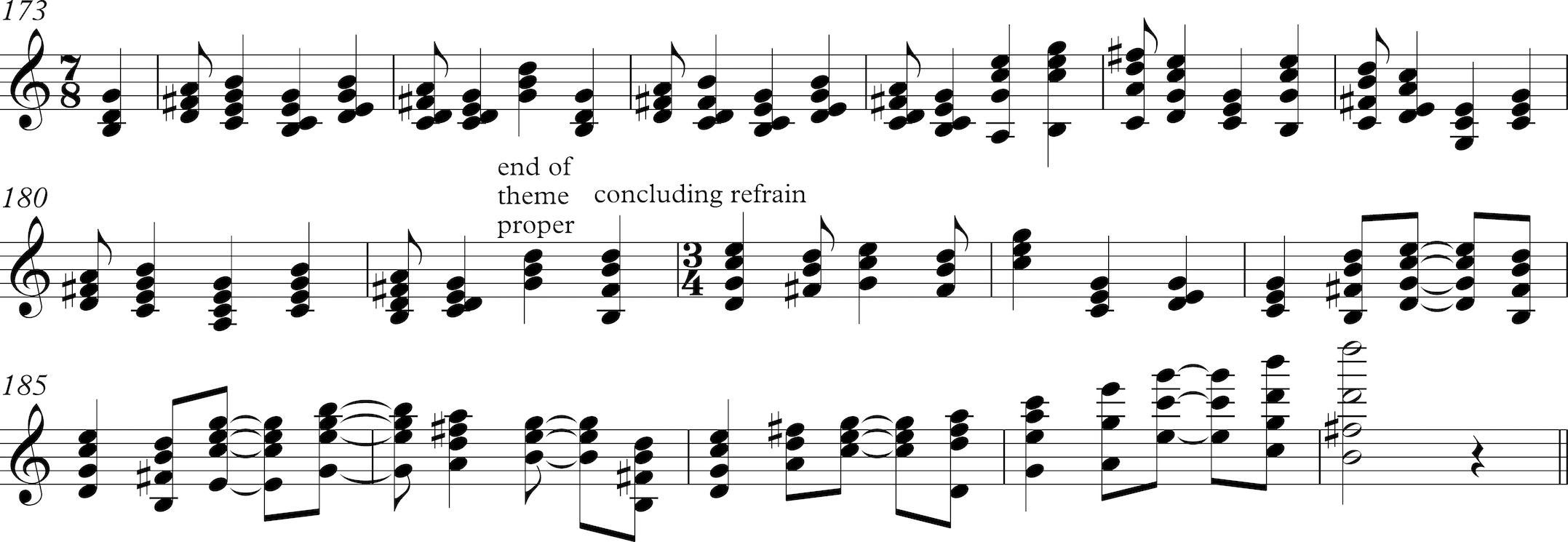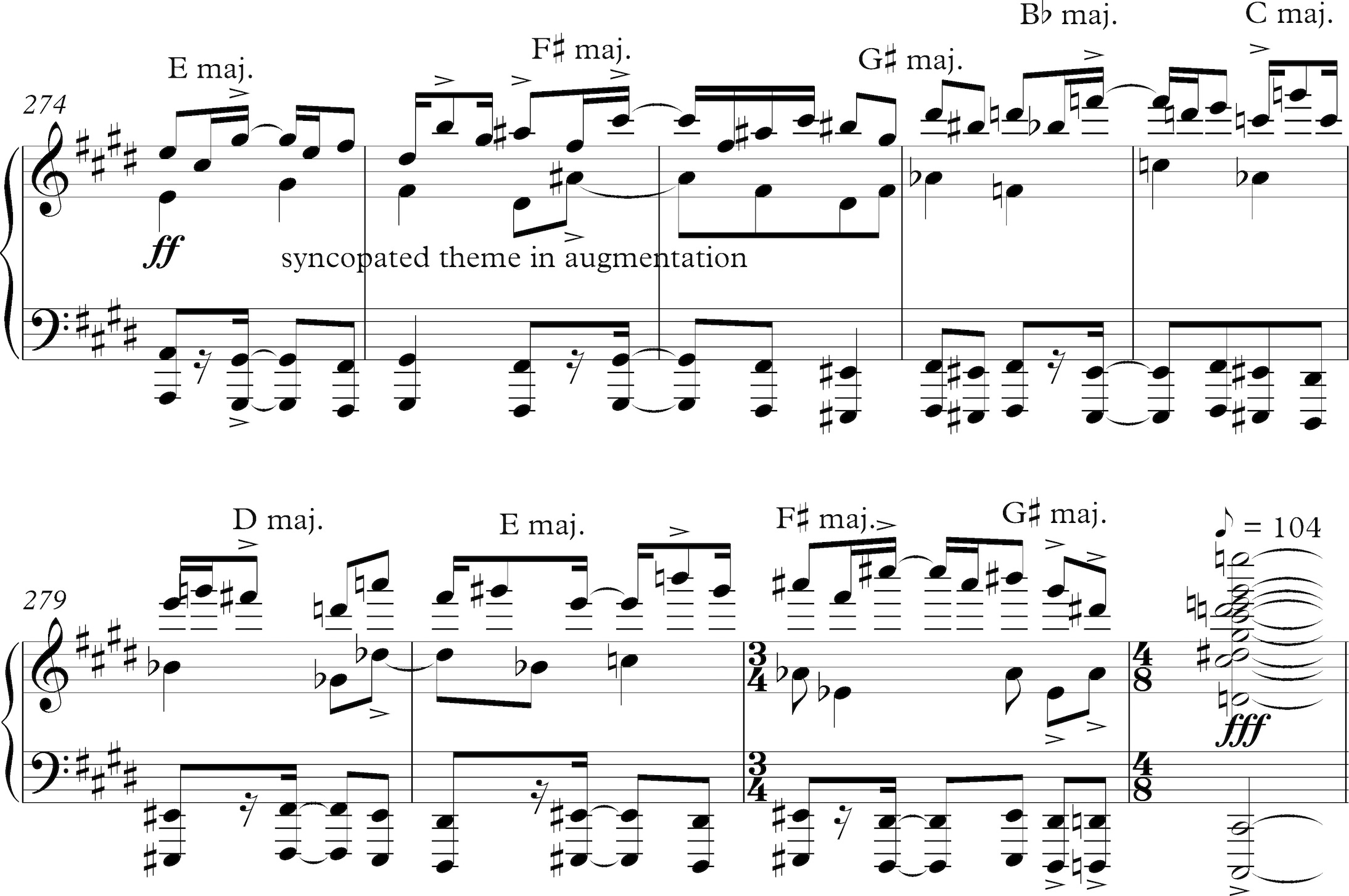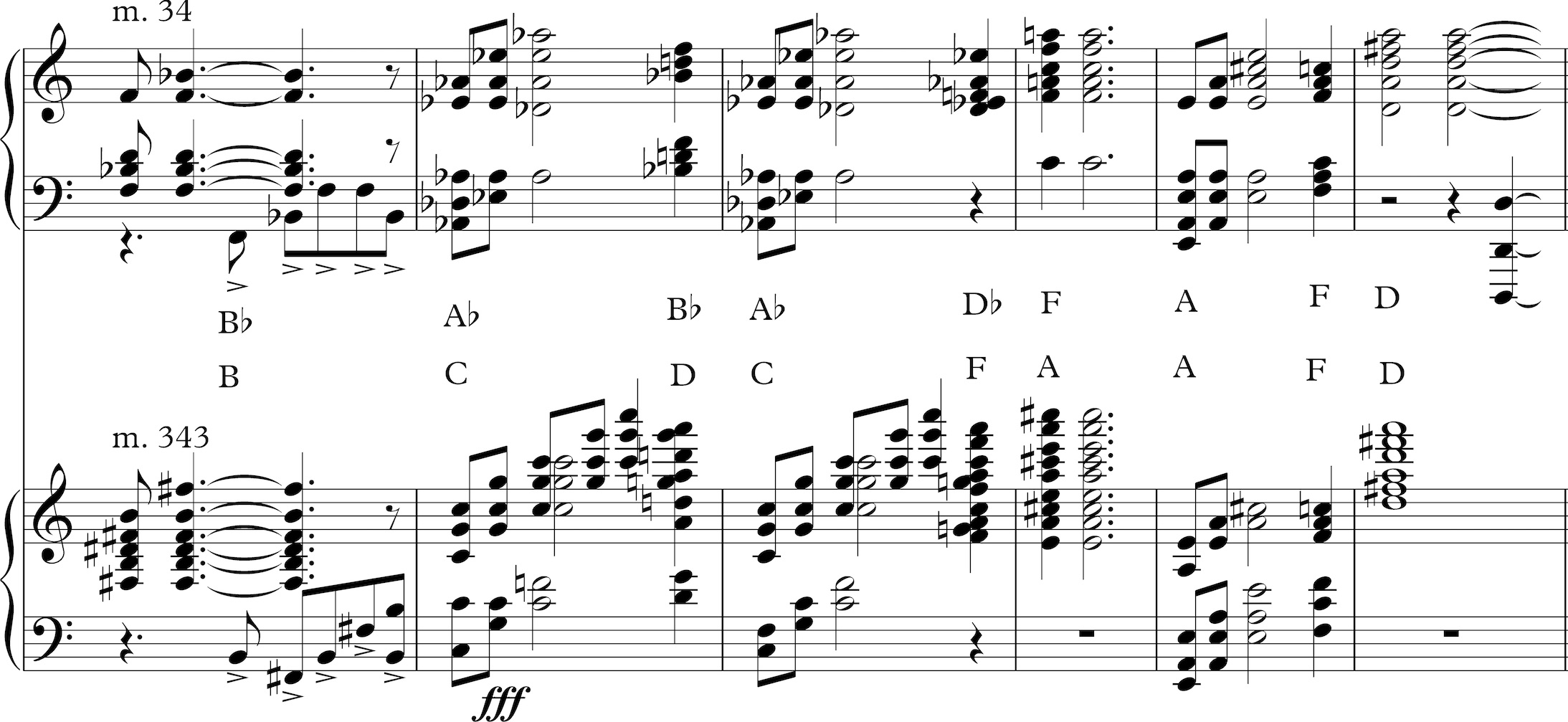Aaron Copland: Symphony No. 3 (1946)
Analysis by Kyle Gann
All score reductions by the author
This work is licensed under a Creative Commons Attribution-Noncommercial 3.0 License.Aaron Copland began sketching his Third Symphony in 1940-41 and completed it in 1946. He had already written three symphonies, the Organ Symphony of 1924 (rewritten without organ as Symphony No. 1 in 1926-28), the Dance Symphony of 1929, and the Short Symphony of 1932-3. Copland considered the Short Symphony his Second, and did not count the Dance Symphony in the numbering. In between his Second and Third Symphonies Copland wrote most of the other works for which he is most famous today: El Salon Mexico (1932-36), Rodeo (1942), Billy the Kid (1938), and Appalachian Spring (1944). Thus the Third was his first symphony to follow his populist works and the stylistic simplification that began with El Salon Mexico, about which he wrote, "It seemed to me that composers were in danger of working in a vacuum... I felt it was worth the effort to see if I couldn't say what I had to say in the simplest possible terms."
Even so, Copland was clearly aware that the world would expect his new symphony to be a grand and serious statement, and the tuneful transparency of Billy the Kid and Appalachian Spring would not show sufficient ambition. This is his first symphony to employ key signatures, but there are passages in which the textures are harmonically complex, polytonal, and even at times atonal. The variety of techniques is astoundingly imaginative, and there are only a few passages (mostly in the second movement) that easily succumb to analysis. Phrase rhythms are remarkably fluid, often dotted by meter changes that the listener won't notice, but which keep the momentum from ever becoming predictable. Though arguments could perhaps be made for the Clarinet Concerto (1947-48), the Twelve Poems of Emily Dickinson (1949-50), and the opera The Tender Land (1952-54), Copland wrote no subsequent works that would land so securely in the standard repertoire.
First movement
Main theme in E -- mm. 1-30
-- Conclusion/Transition to A -- mm. 31-35
Second theme in D, Eb -- mm. 36-53
Third (modulating) theme -- mm. 54-88
Brief return of main theme opening in Eb -- mm. 89-92
Second theme in Eb, Gb -- mm. 93-108
Brief return of third theme -- mm. 109-120
Tense climax -- mm. 121-128
Denouement in E minor/major -- mm. 129-179
Main theme in augmentation (E Phrygian bass) -- mm. 129-159
E major counter-theme -- mm. 160-172
Abbreviated return of first theme -- mm. 173-179The first movement is, overall, the symphony's slowest movement. Its form might be given as a rondo - ABC(A)CBA - but the middle appearance of the A theme is limited to a cadence, while the second C theme seems like only a memory of the first. The main theme, stated at the outset, is a languid, pandiatonic, E-major string melody in triple octaves. (Pandiatonic means that the music is restricted to a diatonic scale, yet all seven notes of that scale can be used freely without any specific one defined as a tonic via triadic syntax.) As is common in Copland's melodies, the melody is harmonically inflected by pivoting into different diatonic scales or modes. First, in mm. 5-7 the melody pivots from an E into eight notes all within the D diatonic scale, giving it a momentary Dorian flavor. After six more measures of E major, m. 14 reintroduces G natural and D natural, restoring the G# immediately afterward. In mm. 27-29, the phrase from mm. 5-7 is transposed upward a fourth, into a G diatonic scale, which has the effect of recentering the music from E major to A.
In terms of its use in the rest of the work, it could be said that the theme proper ends at m. 16, the rest being a rather wandering extension. This is so not only because it is the first 16 measures which will reappear at the end of the movement, but also because at m. 18 the melody thins down to double rather than triple octaves, while an entirely diatonic countermelody enters in chords in the brass.
This counter-theme will reappear to close the movement at m. 160.
Throughout this symphony we're going to find tonalities related by major seconds, and the first appear in the closing transition at m. 31. Modulation by major second does not appear often in the previous classical repertoire, and it still had a fresh sound; the lurch from C to Bb at the beginning of Beethoven's Waldstein Sonata remained exotically anomalous. Moving upward by major second creates a bright, optimistic effect without much disruption of the tonality: C major and D major triads, for instance, can still coexist within one diatonic scale (on G). Modulation downward by a major second has a more relaxing, potentially homey effect, and Copland was clearly fond of both, though the upward form predominates.
As the melody cadences on D-A, it is echoed first on C-G in the horns and trombones, then again on Bb-F in the basses and tuba. This brilliant little passage seems to be in three keys at once, but since the motive it repeats only uses three pitches - A-D-E, C-G-D, and F-Bb-C in the three different implied keys - all of the pitches exist within the F major (D natural minor, or A Phrygian) scale. Any distinction between polytonality and pandiatonicism disappears.
Measures 36-53 introduce a new theme so gentle and so continuing the mood of the first (though with fewer melodic leaps) that it doesn't much establish its own melodic profile. For comparison I will introduce all three and a half statements of this theme here, the first two continuous in D major and then Eb major, the others appearing later, where the partial last statement serves to modulate from Eb to Gb. Deviations from the first statement in subsequent versions are marked with asterisks and brackets.
Despite remaining so similar in character to the first theme, this theme's purpose is transitional. At the beginning it is surrounded by a wealth of decorative motives in the woodwinds and harp, and these proliferate to form countermelodies in eighth-notes, triplets, and finally 16th-notes. These more active lines in the violas and higher winds mostly arpeggiate triads or turn through melodic scales. The music builds and the theme rises in register to a determined cadence in D in m. 54.
The third theme that begins here is more menacingly chromatic than Copland's usual diatonic style; it will dominate some of the third movement as well. Based on a four-measure tune with a squarely simple rhythm, it contains a built-in and not very logical modulation: starting on a minor triad, moving to a raised sixth and raised fourth of the scale, seeming ready to modulate up a fourth but then actually resolving to the key a major second below. In its invariant sixteen beats it uses ten different pitches, only E and Bb lacking in the opening version on D.
The pervasive layering of this theme with itself produces large areas of tonal instability. The tumultuous passage from measures 54 to 79 shows a variety of modulatory strategies leading to some rather dissonant bitonality. The chart below shows only the thematic elements and the tonality-defining drone notes; the theme is accompanied by sawing eighth-notes in tonically static motives of major seconds, fourths, and octaves. The drone on D in mm. 54-60 obscures the fact that the theme actually descends from D minor to C minor to Bb major while it persists. From there the descent in the bass continues through Ab, G (half-step), F, and Eb (first inversion to lead more effectively to the following E minor). The fact that the theme and its contrapuntal echoes lead ever upward while the bass descends makes for a dramatic expansion in the music's register.
At m. 65 the music seems to settle itself on E minor, but predictably descends to D. In mm. 69-76 certain keys are overlaid with each other, bass answering treble, based on pivot tones that have to do with the major/minor ambiguity of the theme itself. Eb minor in the treble is answered by F# minor in the bass, the Gb in treble connecting with the F# in the bass and the Lydian A in the former making the minor third in the latter. As Eb minor turns to major on top, motives in the bass start in G major, the G being common to both keys. Likewise the C# minor in m. 72 turns to major when the theme enters on F in the bass, F equaling E#. Same with C minor and Eb minor in m. 74-75 and C major/E major in m. 76. The shifting bitonality is ear-stretching and tense, but the links between the third of one tonality (major or minor) being the tonic of another keep the modulations within a kind of logic wherein the ear has to shift between the individual lines outlining different keys and the individual chords maintaining a modicum of harmonic sense. Copland's ability to achieve a chaos of tonalities while keeping the listener's ear somewhat harmonically grounded is impressive, and quite in keeping with his philosophy of intelligibility.
Following some chromatic wandering in m. 80, this modulating theme reappears in the original D minor, modulates via pattern to C major, then ascends through D major, E major, and F# major, all whole steps. Meanwhile a C-major scale in the bass descends down to an Eb, and for a moment the music recapitulates the tri-polytonal passage at mm. 31-34 with motives in keys separated by whole steps, Eb, Db, and Cb.
As this passage is a half-step higher than the previous such passage, it climaxes on Bb rather than A as the first one did.
The second theme reappears in Eb, much as in its earlier statement, both given above. At mm. 104-106 it progressively modulates to Gb, landing via voice-leading on a new tonic C# (m. 109).
Nominally the third, modulating theme is recapitulated here, but it is greatly reduced in loudness, energy, and function: more like a memory than a driver of new modulation, and the same will be even more true of this theme's reappearance in the third movement. In fact, rather than the fourth measure marking a push toward new keys, the theme is treated here almost as a thirteen-note row, the final note establishing a temporary new tonic. And since there is a perfect eleventh (perfect fourth plus an octave) between the first and last notes of the four-measure theme, there is even a suggestion of a veiled circle-of-fifths progression. Starting on C# at m. 109, the tone row - anxiously enlivened by repeating 16th-notes in the piano, harp, winds, and strings - moves over fourteen beats to cadence on F#/Gb at m. 113. Here Copland momentarily introduces leaping lines on F#, C#, A#, and D# in his best pastoral mode, as though trying to recreate the second theme's tranquility.
At m. 116, however, the modulating theme starts on Bb (A# of the previous F# major) and continues to a sff high Eb, sustained in tremolo.
The tense climax that ensues from mm. 120-128 does not seem thematically or harmonically motivated by relation to the rest of the movement. The 16th-note flourishes in the strings, brass, and timpani do not occur elsewhere in the movement (though the upward arpeggio flourish in the horns at m. 122 might be deemed an anticipation of the fanfare that opens the fourth movement). The chords in the brass have some similarity to the counter-theme from the first section, but do not quote it. For clarity I give the example without its Eb key signature, relevant to the upper string melody but contradicted by some of the chords. The passage seems calculated simply to bring a moment of focused anguish to this otherwise mostly calm movement.
The climax does aptly set up the serene calm of the remainder of the movement, which has a clear denouement character. The passage in mm. 129-159 is quite remarkable for its static, almost motionless serenity. Accidentals are all but absent. First, the cellos and basses wander up and more generally down a Phrygian scale on E, with only one F# (m. 151). In middle register dyads of either B-E or A-E float among the woodwinds, horns, and violas, switching irregularly on either the downbeat or second quarter-note beat. At measure 133 the main theme re-enters in augmentation, first with the E-F#-F#-E-B of mm. 31-34, then recapitulating the opening theme from its fifth through seventeenth measures, with its thirteenth measure omitted. The minor-key austerity is ineffably sad, though the theme in the violins retains its E-major flavor.
At m. 160 the music settles back into placid E major as the bass finally attains a low E and the violins and violas hold a multiple octave B. The winds re-enter with the counter theme from the opening section, now undistracted by the main melody. At m. 173, over bass drone notes of E and B, the sweet opening notes of the movement, not since heard again until now, enter in triple octaves in the upper strings. A final plagal cadence delicately involving harp, viola harmonics, flutes, and clarinet, brings back the A-E dyad that was contrasted with the B-E dyad, bringing the movement to a peaceful close.
Second movement
Introduction -- mm. 1-31
Main theme motto -- mm. 1-22
Introduction of smaller motives -- mm. 23-31A Section -- mm. 32-156
Main theme in F -- mm. 32-45
Main theme tag -- mm. 46-50
Transitional theme (developing 8-5-2-1-2 motive) -- mm. 51-65
Main theme in F -- mm. 66-77
Main theme tag -- mm. 78-81
Transitional theme (developing 1-8-1-2-5 motive) -- mm. 82-111
Main theme in F in augmentation -- mm. 111-134
Main theme tag augmented -- mm. 135-156B section -- mm. 157-229
Theme 1 in F# -- mm. 157-168
Theme 1 in B in canon -- mm. 169-180
Theme 1 in B shifting to C# mm. -- 181-190
Theme 2 in C# -- mm. 191-202
Theme 2 in Eb -- mm. 203-216
Theme 1 in A -- mm. 217-229
Main theme in piano variation in G, as transition -- mm. 230-263A Section -- mm. 264-342
Transitional main theme theme in G -- mm. 264-278
Main theme in C -- mm. 279-293
B Section Theme 1 in canon in F -- mm. 294-316
Main theme tag augmented -- mm. 316-342The second movement, despite its calmer middle section (trio), clearly stands as the symphony's scherzo movement. This is the least dark segment of the entire work, quite in Copland's populist style and with strong echoes of Rodeo and Appalachian Spring.
The elements of the A sections of this loose AABA' form consist of a recurring motto which opens the movement, a tag derived from that motto, and a theme derived from the tag:
The motto is tonally ambiguous because of its reference to Lydian mode, but the opening F and the recurring cadence make it clear that when it is C-F-A-B-C it refers to F major despite the B-natural; the boundary notes an octave apart represent the fifth scale degree, in other words. The tag derived from the motto is played with in varied statements in the introduction, but afterward it invariably follows the main theme (or, in the last case, the B section's first theme).
The main theme, eleven and a half measures long in its most normative form, is quite stable - that is, once it starts it always proceeds to its end with little variation - and is the major landmark giving the movement its basic form. Like the main theme of the first movement, it pivots for a few measures into a foreign key, here from F major (in almost every statement) to Eb major:
In the first statement, the first two cadential F's are extended by eight and four beats respectively, adding three measures to the theme's length. It is a delightfully unified theme; once one begins humming it, one can neither get lost nor fail to proceed to the final climactic note. We will hear the main theme in its entirety five times, as we also hear the B section's main theme five times and the primary transitional passage three times. The movement lasts eight minutes, and we become very familiar with its materials.
The movement begins with a 31-measure introduction that falls into two parts. The first, mm. 1-22, plays with the motto and its gradual development into the tag; the second, mm. 23-31 sends a motive derived the tag - in scale degrees, 8-5-2-1-2 - through various transposition levels. First the motto is played twice by the horns with dissonant punctuations of major sevenths and half-steps. Measures 6-13 then build up the tag, first cadencing on F#, then giving a modified version of the tag in B. In mm. 14-18 phrases of the tag are played canonically and in counterpoint in E and B and then feinting toward F before landing on F# - a joke that will appear more dramatically later in the movement (m. 81).
A sequence brings a fuller statement of the tag in Eb (anchored by a dominant Bb).
The remaining nine measures of the introduction introduce a transitional motive. The penultimate measure of the tag employs the notes F-C-G-Bb. This gives rise to two transitional motives which will be used for fluid modulation, which I have named for the scale steps involved, 8-5-2-1-2 and 1-8-1-2-5:
Measures 23-31 employ mostly the first of these with some anticipation of the second, on Eb, B, stabilizing for a moment on Ab, then Gb and finally focusing on F. Copland will continue playing around the key of F with flat keys suggesting F minor.
The exposition begins in earnest with a full statement of the main theme in the bass in F, mm. 32-46. The accompaniment in repeated eighth-notes fixates on F and C, sometimes sprinkled with dissonant Gbs and Dbs, and when the melody goes into its Eb-major segment, Ebs and Dbs start to dot the undulating string chords as well. The main theme is followed in mm. 46-50 with the full tag as a kind of closing device, as will happen again at mm. 78, 134 (in augmented version), 256. The only statement of the main theme not immediately followed by the tag, in fact, is the final one, where a theme from the B section separates the two.
Following this strong cadence, Copland introduces a transitional passage that will appear three times in the movement, varied at each statement but quite parallel. At the core of these is a repeated-note line that starts in the 1st and 3rd with a single note, then moving to minor-2nd, major-2nd, and finally minor-3rd dyads generally leading downward. The following example compares the three transitional sections; note that the 1st and 3rd are virtually identical, though with slightly different decoration, except that the 3rd is a whole step higher. The second employs different motives and a varied melodic profile, but a comparison of the m2nd, M2nd, and m3rd pattern shows that they are almost exactly parallel.
The first and third such passages focus at first on the 8-5-2-1-2 motive, the second on the 1-8-1-2-5 motive. (The second is actually barred differently, with a couple of 2/4 measures). All of them reach - at mm. 59, 106, and 272 respectively - a playfully frantic climax theme, giving way to a rising crescendo that leads back to the main theme.
The first transitional section returns to a statement of the main theme in its normative form with closing tag, mm. 66-81. This, however, has a surprise ending on F#, echoing the smaller such effects in the introduction. An episode in mm. 82-96 more fully introduces the 1-8-1-2-5 motive, taking it playfully through the triton-related keys of D, Ab, B, and F. At m. 97 the second transitional section arrives, progressively distorting the 1-8-1-2-5 motive. Once again, the transitional material arrives at a grand statement of the main theme in augmentation, decorated by outbursts of the 1-8-1-2-5 motive. At m. 119 the tune is momentarily (and ominously) inflected by F minor. The following tag extends the drama by augmenting the motto into whole and half-notes, as will be paralleled again at the end of the movement.
So far we've had an introduction and three statements of the main theme, these statements separated by parallel transitional material. Once again we get an F/F# contrast as a high F is held in the strings (m. 155) and the oboe introduces the B section in F# major. The more relaxed B section (mm. 157-230) is comprised of two themes, both entirely diatonic and in Copland's best populist idiom. The first lends itself to canon, and though it is first stated by a solo oboe in F# (accompanied by sustained major second dyads that obscure the tonality in places), its second statement, in B, is a canon between the English horn and bass clarinet:
That the first two notes in this example are D# and C# rather than G# and F# is a continuation of the transition downward a fifth in pitch. That the tune features a triple-eighth-note upbeat in alternating measures means that this figure flows back and forth attractively between the two voices.
The second, more flowing theme is also in 3/4. Not canonic, it is stated against a syncopated bass ostinato which cleverly hits a seventh below the downbeat note on the second eighth beat for the first five measures (an upside-down 7-6 resolution):
Interestingly, if minor, the second statement of the theme adds an extra two-measure phrase at mm. 204-205, delaying the tune's rise up the scale and extending the theme from twelve measures to fourteen.
The entire B section comprises three statements of the first theme, two of the second, and another of the first in the following key pattern:
Measure: 157 169 181 191 203 217 Theme: 1 1 1 2 2 1 Key: F# B B > C# C# Eb A Only the second statement uses the canon, though that canon will return triumphantly at the movement's final climax. The third statement shifts freshly from the keys of B to C# by repeating a phrase and extending the leaping interval upward by an extra major second.
For obscure reasons the second statement of theme 2 is notated in a key signature of six flats, even though every D and G is natural and the Eb-major tonality is maintained without deviation. As a result there is a complex-looking key change at m. 203, from five sharps to six flats, though actually from C# major to Eb major, another of Copland's favorite upward major-second shifts (as in the previous B to C#). It is effected by the simplest of devices: the final dominant in the second statement - G# B# D# - acts as pivot to the subdominant of Eb - Ab C Eb - and both spellings are found in the score (m. 203). The sudden tritone shift from Eb to A at m. 217 comes as a quiet, palate-cleansing surprise. The key signature here is G major, not A, but the music will move to G major following this statement of theme 1.
Measures 230-255 transition back into the A material by having a variation of the main theme (now in 2/4) return in G major. It is played by the piano, and made more sparklingly pianistic by replacing some of the eighth-notes by pairs of alternating 16th notes.
By keeping the texture light (as in the B section) but returning to duple meter and the lightly disguised main theme (as in the A sections), this passage serves to move smoothly from one to the other, though for thematic reasons one might want to consider it the lightly articulated beginning of the final A section. The accompaniment is delicate and rhythmically ambiguous: one bass octave and one treble cluster per 2/4 measure, rhythmically varied measure by measure, though repeating in a subtle five-measure pattern (R stands for eighth-note rest, C for treble cluster, B for bass octave:
RRCB
RBCR
RRCB
RCRB
RCBR
RRCB and so on
High woodwind figures from the second transitional theme are scattered in, and the bass octaves and treble chords begin (at m. 245) moving outward in opposite directions through a tonal progression that has little to do with the theme, but whose voice-leading gives a moment of logical-sounding bitonality.
The following tag in the winds (mm. 255-263) segues directly into the third transitional section at m. 264, a recapitulation of the first such passage a major second higher. Despite the transposition, the transition's closing scale leads up to a climactic G, as the first did; this time, however, the main theme enters of the key of C. The accompaniment is in repeated eighth-note chords involving much of the orchestra. At the theme's end, instead of the usual tag, we get a three-measure transition (mm. 291-293; curiously, the ambiguity-creating chords are on C# and Eb, two keys that collided in the B section) leading to a grand statement of the B section's theme 1, in canon between treble and bass, and in F despite a key signature of Bb.
At the theme's end, its F-F-A-G-F motive gets stuck in the groove, so to speak (m. 313), and the brass start filling the texture with the opening motto. The final tag now returns (m. 317) even more augmented than in mm. 135-156, with the upbeat quarter-notes turned into half-notes, and the penultimate half-notes into whole-notes, ending on a maximally loud high F octave and a final timpani blast.
Once again we note the long-term major second relations among sections: the main theme in F contains a segment in Eb; that theme's first statement not in F is in G; the B section's first theme rises through the keys of B, C#, and Eb; and the last transitional theme is a whole-step higher than the first.
Third Movement
Slow section -- mm. 1-110
Modulating theme -- mm. 1-29
---- Cadence -- mm. 30-33
Modulating theme -- mm. 34-56
---- Cadence -- mm. 57-64
Wedge theme w/ ostinato -- mm. 65-98
Transition -- mm. 99-110Fast section -- mm. 111-189
Wedge theme in F -- mm. 111-126
Dotted-note theme in F -- mm. 127-136
Dotted-note theme in A -- mm. 137-157
Octave wedge theme in G -- mm. 158-171
Wedge theme in A -- mm. 172-189Slow section -- mm. 190-234
Wedge var. w/ ostinato -- mm. 190-218
Mod. theme recap -- mm. 219-228
---- Cadence -- mm. 229-234The third movement would seem to be cast as the slow movement, but most of its middle is in a rather quick tempo. The movement revolves around two themes: the modulating (third) theme from the first movement and a quicker tune I will call the wedge theme, since its notes get ever closer together in a quasi-minimalist additive process. The modulating theme is largely recast in 5/4 meter by the simple expedient of replacing the first movement's two quarter-notes and a half-note with a quarter and two halves.
The wedge theme, around which most of the movement revolves, is a versatile formula in which an octave on the dominant narrows down progressively to a final note on the tonic. (Since in other works I've analyzed a "wedge" starts on a single pitch and moves progressively outward in both directions, the punctilious might want to label this a reverse-wedge theme.)
It is worth considering the opening of this theme as a possible quasi-inversion of the first movement's main theme: similar contour, same key (at first), with the G#-A-B progression reversed to B-A-G#.
The movement opens with the modulating theme in its 5/4 form with the 13 original notes from B to E an eleventh higher. Starting from E, Copland then employs two statements of an altered modulating theme (mm. 7-12 and 12-19), with the minor triads reversed in direction - the first descends instead of rising, and the last rises instead of descending. The second violins' counterpoint in mm. 13-19 also uses this form of the theme, but with the second three-note phrase missing. In mm. 22-28 the original form returns in the first violins (first note in the second violins). This passage is basically atonal (despite the B-minor key signature), but there is hardly any dissonance, and most of the dissonant notes are passing tones. The final cadence is shaped to give triads in a whole-tone array on E, D, F#, and G#.
A gentle five-chord cadence follows leading to C#, a model for one that will occur a few more times in the movement, including at its end.
The second large phrase opens (m. 34) with the modulating theme on D#, but it is interrupted after three measures (its first five notes). The music turns to a chord progression going through F# minor, D major, C major, and then a ii7-V-I in D. Measures 42-56 are a tense passage emphasizing minor thirds in most lines and major thirds vertically, only momentarily suggesting a momentary tonality here and there. A climax at m. 50 descends by mm. 54-56 into a C minor scale with its repeating C-Eb in the violas and bassoons rendered ambiguous by dissonant minor sevenths in the violins and winds.
Two cadential progressions ground the music back in tonality, each cadencing on D, though the second begins a fifth higher. The D cadence is followed, though, by an F# minor triad that come to rest on an E-major triad that serves as the onset of the next section.
When the second phrase reappears at the end of the movement (m. 229), the F# minor chord, instead of dropping a whole-tone to E major, will rise a whole-tone to Ab major.
The modulating and wedge themes are so dissimilar in spirit, contour, and tonality that a composer might despair of making a unified movement from them, but Copland's strategy is quite ingenious. Starting at m. 65 he begins to additively introduce the wedge theme in E major, virtually note by note, cadencing twice by alternating between melodic E major and D major triads at mm. 71 and 76 - his usual major-second bitonality. This could have easily become the articulation of the B section of an ABA, but at m. 77 he pulls back into ambiguous chromaticism again, leaving some of the wedge theme notes present but floating them, so to speak, over a chromatic, rhythmically irregular ostinato and alto motives that emphasize the minor third and tritone of the modulating theme. The result, in mm. 77-100, is a peculiar blend of the two atmospheres, delaying the full exposition of the wedge theme by some 24 measures. The contrapuntal lines of this passage flow back and forth among different instruments, and it is worth sorting them out here to unravel the complexity of this hypnotic passage.
Rising from a G# in the cellos at m. 76, an ostinato (traded back and forth among the strings) repeats G#-A#-B-A, then slides up to B-C-C# at m. 87, finally settling on an alternation of A# and B as the gesture becomes more focused and anticipatory. A line just above this emphasizes E and G natural, later A and F#, easing up to a Bb in m. 86. Above these two lines mostly in E minor cross each other, eventually adding back motives from the wedge theme. Copland will later ease out of the sprightly middle section of the movement by recapping these lines in a similar passage at mm. 192-215.
At last the wedge theme picks up steam in a longer version that accelerates from m. 98 to m. 108, with a high-register detour leading to the opening motive moved down a third.
A cadence on E-B-E is followed by flourishes suggesting the keys of D and Eb, and then we are in the B section proper. This faster section divides into five large phrases as follows:
Wedge theme in F, with transition -- mm. 111-126
Dotted-note theme in F, moving to flat keys -- mm. 127-136
Dotted-note theme in A, leading to subsidiary theme -- mm. 137-157
Octave wedge theme in G -- mm. 158-171
Wedge theme in A changing to C# and then E -- mm. 172-189Within the wedge theme in its simplest form, at m. 112, is interpolated a dotted-note motive that becomes the model for a contrasting theme that dominates the second and third of these passages.
Though centered at first in F, this section moves bitonally to a more stable statement in A that moves into a countermelody in Copland's most populist style.
The fourth phrase, mm. 151-171, at first turns the wedge theme into an outward wedge, starting with octaves and leaping ninths and then tenths. As the bass slides downward in bitonal flatted notes, the melody in 162-171, in the top melody, then almost exactly parallels the melody in its earlier form at mm. 98-108.
The final phrase states the theme in E (with some arpeggios as rhythmic interruptions), followed by another statement in C# at m. 179. At m. 183 the 16th-note arpeggios disappear and the texture simplifies, abruptly shifting a minor third at m. 187. From here the music blends smoothly into a varied recap of the passage with the chromatic arpeggio already heard in mm. 76 to 98, now slightly longer in mm. 192-216.
Three dyads in the strings echoing previous notes lead us to the final portion. Over A-B dyads in the strings, harp, and celesta (reminiscent of the A-B alternation in the denouement of the first movement), the modulating theme is heard in its original 5/4 version one last time in the piccolo and violin harmonics, from B up to E, its final minor triad then repeated an octave higher. A final chorale cadence is repeated from mm. 60-64 at mm. 229-234, only this time the penultimate F#-major triad cadences a whole-step upward to an Ab-major triad instead of downward. This triad in the lower strings is sustained into the next movement.
Fourth Movement
Fanfare for the Common Man -- mm. 1-39
Section 2, turn theme
Turn theme in D + fanfare -- mm. 40-52
Turn theme in E, F#, Ab, Bb -- mm. 53-61
Turn theme recap in C -- mm. 62-69
in Eb, Gb, Db, D -- mm. 70-84
Syncopated chords + theme in D, E, F# -- mm. 85-106
Turn theme recap in E -- mm. 107-121
Syncopated chords modulating -- mm. 122-126
Turn theme in F -- mm. 127-148Section 3, 7/8 theme
Fanfare w/ diatonic theme in B -- mm. 149-160
Quieter fanfare in F -- mm. 161-173
7/8 theme -- mm. 174-232
--- in G -- mm. 174-191
--- in D -- mm. 192-209
--- in Eb, modulating -- mm. 210-232
Syncopated theme -- mm. 233-281
--- in F -- mm. 233-248
--- in D -- mm. 249-261
--- in E, modulating -- mm. 262-281
Climax -- mm. 282-290Section 4, themes combined
Turn theme in Ab -- mm. 291-300
Fanfare in Gb -- mm. 301-314
Fanfare in G + 1st mvmt theme -- mm. 315-326
7/8 theme + 1st in 4/4 in D -- mm. 327-334
7/8 theme + fanfare in B -- mm. 335-339
Fanfare recap in B, C, A -- mm. 340-349
7/8 theme in 4/4 in D -- mm. 350-364
Fanfare, 1st allusions in D -- mm. 365-374The fourth is the longest movement, and its form is quite complex to chart, not reducible to any traditional sonata movement form. However, it is made up of three major themes: one derived from Copland's earlier work Fanfare for the Common Man; a main theme I will call the turn theme; a new theme entering halfway through that I call the 7/8 theme; plus one theme derived from the turn theme material that I will call the syncopated theme.
The first 39 measures of the movement consist of a lightly revised version of the Fanfare for the Common Man (1942). The opening percussion gestures of that piece are omitted, and the points of percussive punctuation are moved around; a couple of phrases are altered, or switched around. The fourth movement begins quietly in the woodwinds instead of loudly in the trumpets, as in the original.
Most effectively, the key structure changes. The original Fanfare remains in Bb up until the very end, then going through a series of triads to end in D major. Here the tonality starts in Ab, shifts abruptly to C at m. 11, then to B at m. 18, and more circuitously to Bb at m. 27. At the end (mm. 35-39) the movement follows the original fanfare: the tonality drops a whole step near the end, then through a series of triads rising toward unexpectedly sharper keys: in this case, Bb to Ab, then F major to A major, then back to F major for a cadence on D major, the key in which the movement will triumphantly end - a tritone away from the opening in Ab.
These changes provide a symphonic continuity more in keeping with the rest of the symphony than the original, rather static Fanfare would have done. The fanfare material will return in mm. 148-173 and off and on from 301-372, present in some 115 measures of the total 374.
Phrases from the fanfare continue to echo through m. 46. Above them, a new theme begins hesitantly, which I call the turn theme based on its tendency to circle around a single note (mostly the dominant).
This malleable and infinitely extendable tune, reminiscent of folk fiddling, is a fertile generator of pandiatonic material, and it dominates the music, with momentary interruptions, for the next 121 measures. It also spins off motives that take on a life of their own, including one that I call the syncopated theme, that appears in m. 53 and will later dominate measures 233 to 281.

Rampant running scales and repeated notes are also used to sustain the texture. Twice, at mm. 61 and 107, the turn theme will seem to regenerate itself and start over by leaping up several octaves and reinitiating the original tune. Having started in D, from measures 53 to 69 this material will rush upward by whole-steps through an entire whole-tone scale, E, F#, Ab, Bb, arriving at C.
Twice, at mm. 85-106 and 122-126, the turn theme material is interrupted by a series of chords marked by quarter/eighth syncopations that prefigure a later theme that I will call the 7/8 theme. The first of these passages modulates by upward whole steps from D to E to F#; the second modulates more quickly and sporadically to a long climactic passage in F.
A climax and precipitous descent brings this long passage to a close, and the music returns to the fanfare theme in various levels of augmentation. As so often when Copland wants a total change in atmosphere, the tonality jumps by a tritone, here from F to B. As the fanfare theme still lingered as the turn theme was being introduced, so here the turn theme at first hovers about the fanfare material. After a dramatic stop at m. 160, both themes start up again more quietly, and again in F. This passage is prelude to the 7/8 theme, which begins on the upbeat to m. 174. The melody always has an eighth-note on the downbeat of the new 7/8 meter, with quarter-notes elsewhere. The harmonization is crucial to the melody, and while the upper parts are all triadic, the bass note is often a non-triad-member that inflects the harmony pandiatonically.
At m. 189 Copland begins a variation on this theme in D major: the winds play a melodic variation on the theme, answered phrase by phrase in the strings and horns with a 4/4 version in which the second quarter-note in each phrase becomes dotted. In mm. 208-9 the chords leap up from D minor to F major to Ab in preparation for a further statement of the 7/8 theme in its original version. In mm. 221-227 a modulatory set of triads is inserted between the theme and its concluding refrain, so that the latter ends up again in D.
At m. 233 the music shifts abruptly to F major, and the syncopated theme starts up on its own in a quasi-canonic form. The brass hammer on an F-E dyad throughout this passage, moving eventually to F-G, D-E, and so on. At m. 249 the theme starts up again in a G major that gives way to D major, changing smoothly to E major at m. 260-262. At m. 265 the trumpets and horns play the theme in augmentation as the winds and strings continue at the original speed. Once again, the theme begins rising through a series of keys by rising whole steps: F#, G#, Bb, C, D, E, F#, G#, over a chromatically ambiguous bass line.
Measures 282-290 bring a dramatic cessation of activity and a dissonant crisis, an orchestral tutti of a C#-minor triad with D-naturals in multiple octaves. The piccolo and flute return to the hesitant beginning of the turn theme again, much as they did after the original fanfare had ended at m. 40, only now in 32nd-notes instead of 16ths. The rest of the movement, growing toward a climax, is concerned with combining themes heard earlier. At m. 301 the bassoons and horns begin the fanfare theme, turning the woodwinds' turn theme from Db major to Gb. From m. 310 the main focus becomes the fanfare theme, as the two harps, piccolo, and flute sweep ethereal scales up and down on Gb-major scales with F-naturals at the top and F-flats on bottom.
Measure 315 brings a shift to G major, and the violins quietly play the first movement's main theme over motives from the fanfare theme. After that theme's first seven measures, the music plunges back to D major (m. 327), and the strings now play the 7/8 theme regularized into 4/4 in pure quarter-notes, while the horn and trumpet play the first movement's main theme again. For a few bars the two themes fit so well one might think they were planned together.
At m. 335 the tonality shifts abruptly to B major; the strings play the first two phrases of the 7/8 theme with the cadential notes extended, while motives from the fanfare theme ripple through the brass.
A pause comes at m. 340, and the finale of the Fanfare for the Common Man returns in its original form as heard from mm. 31 to 39. Since this passage starts in B rather than Bb, though, the harmonic progression is altered. First, rather than shift down a whole step from Bb to Ab as the original does at m. 35, it shifts upward a half-step from B to C. For the next three bars the two passages are parallel, the second a major third above the first in tonality. At m. 38, though, Copland had followed up a Db to F shift with another major third to A. At 347, instead of making that next major third jump he just keeps the harmony on A, and, voila, he is poised to end the passage on D again.
In mm. 349-365 the 7/8 theme appears in augmentation, regularized to an invariant series of half-notes in the brass and basses, as the strings and winds hammer at repeated fifths and then more pandiatonic chords. From m. 365 to the end motives from the fanfare theme rise up from the bass as the orchestra sustains pitches D, A, and E, finally resolving to an orchestral tutti D major triad.
It should be said that, unlike in the works of Beethoven and other earlier composers, in which an ambiguous theme might ultimately appear in a more consonant, triumphant version, this 4/4 appearance of the 7/8 theme does not suggest resolution. Where the original version of the theme has an attractive spontaneity to it, this latter variation is comparatively square and official. I would say, in fact, that the only flaws in this otherwise magnificent symphony are that in the final climaxes of the second and fourth movements, themes that were exquisite in their original delicate statements are forced into bombastic (the word comes up in descriptions of the piece), even militaristic garb for their grand apotheoses. Copland clearly felt a need for the overwhelming finale, but his wonderful themes were not always suited to that use.
As a final thought, it seems ambiguous how much Copland thought in terms of large-scale harmonic structure. The first movement begins and ends in E, has a passage in D and a modulating theme opening in D minor, and climaxes in or on Eb twice. The second movement is basically in F, with some playful shifts to F# and a middle section that traverses a whole-tone collection of keys, B, C#, Eb, A, and G. The third movement tonality starts nebulously, but its quicker section is framed in E, with forays into F, G, and A. The finale modulates almost too often to generalize about, but it opens in Ab only to modulate distantly and by stages to a triumphant D major, in which it will also end. A dramatic contrast between keys of F and B divides the movement in half, and a primary theme in 7/8 first appears in G. Some intriguing pitch correspondences between the first and third movements (involving A and B) have been noted, and the keys D, E, and F are notably important in the work. My impression, though, is that Copland modulated more for momentary color than for some background harmonic scheme.
Copyright 2019 Kyle Gann
Return to American Symphonies
Return to the home page
